Paul van Yperen's Blog, page 345
May 22, 2016
Hannes Jaenicke
German actor Hannes Jaenicke (1960) has played in hundreds of films and TV productions, both in Germany and the USA. His best known film is probably the elevator thriller Abwärts/Out of Order (Carl Schenkel, 1984).
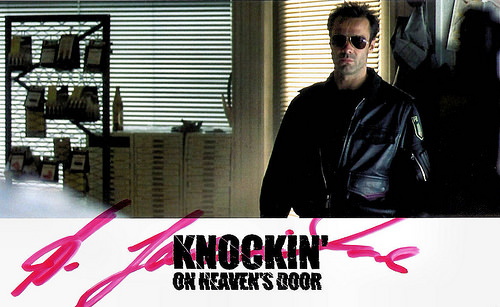
German autograph card. Photo: publicity still for Knockin' on Heaven's Door (Thomas Jahn, 1997).
An elevator as an allegory
Hannes Jaenicke was born in Frankfurt am Main, West-Germany (now Germany), in 1960. He is the son of biochemist Rainer Jaenicke and musician Agatha Calvelli-Adorno. Soon after he was born, his family moved to Pittsburgh, Pennsylvania. They remained there until he was ten years old.
Hannes studied acting at the Max-Reinhardt-Seminar in Vienna from 1979 to 1982. He also studied at the London School of Modern Dance and worked as a dancer in the musical My Fair Lady. Between 1980 and 1989, he played 16 leading roles in different theatre productions at Burgtheater Wien, Volkstheater Wien, Schauspiel Bonn, Freie Volksbühne Berlin, Schauspiel Köln, and Festspiele Salzburg.
His first major film was the provocative thriller Abwärts/Out of Order (Carl Schenkel, 1984), about four very different people (also Götz George , Wolfgang Kieling and Renée Soutendijk) who get trapped in an elevator of an office tower. The stuck elevator served as an allegory for modern German society, and the film was received favourably by both audience and critics.
Two years later Jaenicke appeared in the drama Die Geduld der Rosa Luxemburg/Rosa Luxemburg (Margarethe von Trotta, 1986), featuring Barbara Sukowa. Luxemburg was a leader of both the German and Polish Socialist parties who advocated an anti-colonialist and pacifist stance on the issues of her day. The film and Sukowa both won the 1986 German Film Award for, and Sukowa also won the Cannes Film Festival's Best Actress Award for her performance.
Hannes Jaenicke reunited with director Carl Schenkel for Zwei Frauen/Silence like Glass (Carl Schenkel, 1989), which was made in Germany, but set in America. The film featured an American cast including Jami Gertz and George Peppard, with all English dialogue.
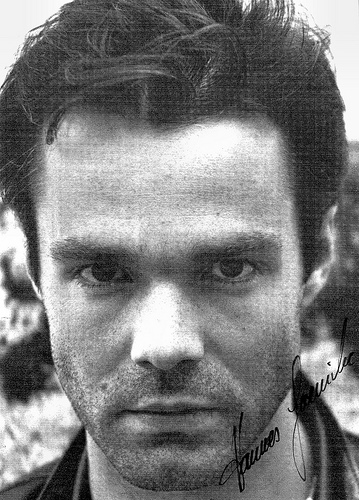
German autograph card.
Two terminal and drunken patients on a road trip
In the 1990s, Jaenicke started to work internationally. He co-starred with an American cast in the German film Die Tigerin/The Tigress (Karin Howard, 1992). The film portrays Berlin in the 1920s and features a charismatic con-artist and his girlfriend (James Remar and Valentina Vargas) who devise a diabolic plot to con a wealthy American (George Peppard) but they end up entangled in a game of seduction and vendetta.
Jaenicke played a supporting part in the German criminal comedy Knockin' on Heaven's Door (Thomas Jahn, 1997) starring Til Schweiger and Jan Josef Liefers as two terminal patients, who leave their hospital beds, drunk and in pyjamas, and steal a Mercedes convertible for one last trip to the sea.
That year, he also appeared in another popular road movie, Bandits (Katja von Garnier, 1997), starring Katja Riemann. Both Germans films were big box office hits in Germany but less successful abroad.
In between these interesting films, Jaenicke mostly had to appear in mediocre TV films. So he decided to try his luck in Hollywood, where he appeared in several B-films and TV series.
His American work included the action crime thriller The White Raven (Jakub Z. Rucinski, Andrew Stevens, 1998 starring Ron Silver, the black comedy/drama Five Aces (David Michael O'Neill, 1999) with Charlie Sheen, and the crime thriller Restraining Order (Lee H. Katzin, 1999) starring Eric Roberts.
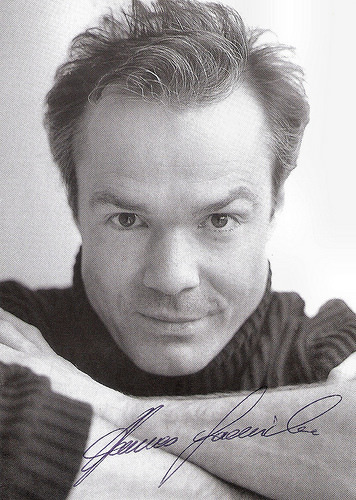
German autograph card by Hannes Jaenicke Internationaler Fanclub, Lossburg.
A Hollywood career going nowhere
Hannes Jaenicke continued his wobbly Hollywood adventure with supporting roles in the action film Lost Treasure (Jay Andrews, 2003) starring Stephen Baldwin, and the action comedy Blast (Anthony Hickox, 2004).
Obviously, Jaenicke’s Hollywood career went nowhere, and he returned to Germany, where he could play leading roles in TV films. Incidentally, he appears in interesting German films like Waffenstillstand/Ceasefire (Lancelot von Naso, 2009) with Matthias Habich and Thekla Reuten, and Einfach die Wahrheit/Simply the truth (Vivian Naefe, 2013).
On television, Jaenicke reprised his role of widowed ex-soldier and triple father Harald Westphal from the successful TV film Allein unter Töchtern/General Dad (Oliver Schmitz, 2007) for the sequels Allein unter Schülern/Alone among students (Oliver Schmitz, 2009), Allein unter Müttern/Alone among mothers (Oliver Schmitz, 2011), Allein unter Nachbarn/Alone among neighbours (Oliver Schmitz, 2012) and Allein unter Ärzten/Alone among doctors (Oliver Schmitz, 2014).
Jaenicke wrote and produced the documentary Ihr seid Helden!/You are heroes! (Eva Gfirtner, Elisa Weiland, 2014) in which he met doctors in crisis areas. He is a passionate environmentalist and made TV documentaries about the life of endangered species such as orangutans, polar bears and sharks.
From 199 till 2001 Hannes Jaenicke was married to Nicole. He was formerly engaged to actress Tina Bordihn. Hannes Jaenicke lives in Cologne and Los Angeles. IMDb mentions various new films with Jaenicke in production, including the German buddy-comedy Männertag/Men’s Day (Holger Haase, 2016).
German trailer for Abwärts/Out of Order (Carl Schenkel, 1984). Source: MrSubkulturTV (YouTube).
Trailer Restraining Order (1999). Source: The Actionmaster (YouTube).
Sources: Filmportal.de, AllMovie, Wikipedia (German and English) and .

German autograph card. Photo: publicity still for Knockin' on Heaven's Door (Thomas Jahn, 1997).
An elevator as an allegory
Hannes Jaenicke was born in Frankfurt am Main, West-Germany (now Germany), in 1960. He is the son of biochemist Rainer Jaenicke and musician Agatha Calvelli-Adorno. Soon after he was born, his family moved to Pittsburgh, Pennsylvania. They remained there until he was ten years old.
Hannes studied acting at the Max-Reinhardt-Seminar in Vienna from 1979 to 1982. He also studied at the London School of Modern Dance and worked as a dancer in the musical My Fair Lady. Between 1980 and 1989, he played 16 leading roles in different theatre productions at Burgtheater Wien, Volkstheater Wien, Schauspiel Bonn, Freie Volksbühne Berlin, Schauspiel Köln, and Festspiele Salzburg.
His first major film was the provocative thriller Abwärts/Out of Order (Carl Schenkel, 1984), about four very different people (also Götz George , Wolfgang Kieling and Renée Soutendijk) who get trapped in an elevator of an office tower. The stuck elevator served as an allegory for modern German society, and the film was received favourably by both audience and critics.
Two years later Jaenicke appeared in the drama Die Geduld der Rosa Luxemburg/Rosa Luxemburg (Margarethe von Trotta, 1986), featuring Barbara Sukowa. Luxemburg was a leader of both the German and Polish Socialist parties who advocated an anti-colonialist and pacifist stance on the issues of her day. The film and Sukowa both won the 1986 German Film Award for, and Sukowa also won the Cannes Film Festival's Best Actress Award for her performance.
Hannes Jaenicke reunited with director Carl Schenkel for Zwei Frauen/Silence like Glass (Carl Schenkel, 1989), which was made in Germany, but set in America. The film featured an American cast including Jami Gertz and George Peppard, with all English dialogue.

German autograph card.
Two terminal and drunken patients on a road trip
In the 1990s, Jaenicke started to work internationally. He co-starred with an American cast in the German film Die Tigerin/The Tigress (Karin Howard, 1992). The film portrays Berlin in the 1920s and features a charismatic con-artist and his girlfriend (James Remar and Valentina Vargas) who devise a diabolic plot to con a wealthy American (George Peppard) but they end up entangled in a game of seduction and vendetta.
Jaenicke played a supporting part in the German criminal comedy Knockin' on Heaven's Door (Thomas Jahn, 1997) starring Til Schweiger and Jan Josef Liefers as two terminal patients, who leave their hospital beds, drunk and in pyjamas, and steal a Mercedes convertible for one last trip to the sea.
That year, he also appeared in another popular road movie, Bandits (Katja von Garnier, 1997), starring Katja Riemann. Both Germans films were big box office hits in Germany but less successful abroad.
In between these interesting films, Jaenicke mostly had to appear in mediocre TV films. So he decided to try his luck in Hollywood, where he appeared in several B-films and TV series.
His American work included the action crime thriller The White Raven (Jakub Z. Rucinski, Andrew Stevens, 1998 starring Ron Silver, the black comedy/drama Five Aces (David Michael O'Neill, 1999) with Charlie Sheen, and the crime thriller Restraining Order (Lee H. Katzin, 1999) starring Eric Roberts.

German autograph card by Hannes Jaenicke Internationaler Fanclub, Lossburg.
A Hollywood career going nowhere
Hannes Jaenicke continued his wobbly Hollywood adventure with supporting roles in the action film Lost Treasure (Jay Andrews, 2003) starring Stephen Baldwin, and the action comedy Blast (Anthony Hickox, 2004).
Obviously, Jaenicke’s Hollywood career went nowhere, and he returned to Germany, where he could play leading roles in TV films. Incidentally, he appears in interesting German films like Waffenstillstand/Ceasefire (Lancelot von Naso, 2009) with Matthias Habich and Thekla Reuten, and Einfach die Wahrheit/Simply the truth (Vivian Naefe, 2013).
On television, Jaenicke reprised his role of widowed ex-soldier and triple father Harald Westphal from the successful TV film Allein unter Töchtern/General Dad (Oliver Schmitz, 2007) for the sequels Allein unter Schülern/Alone among students (Oliver Schmitz, 2009), Allein unter Müttern/Alone among mothers (Oliver Schmitz, 2011), Allein unter Nachbarn/Alone among neighbours (Oliver Schmitz, 2012) and Allein unter Ärzten/Alone among doctors (Oliver Schmitz, 2014).
Jaenicke wrote and produced the documentary Ihr seid Helden!/You are heroes! (Eva Gfirtner, Elisa Weiland, 2014) in which he met doctors in crisis areas. He is a passionate environmentalist and made TV documentaries about the life of endangered species such as orangutans, polar bears and sharks.
From 199 till 2001 Hannes Jaenicke was married to Nicole. He was formerly engaged to actress Tina Bordihn. Hannes Jaenicke lives in Cologne and Los Angeles. IMDb mentions various new films with Jaenicke in production, including the German buddy-comedy Männertag/Men’s Day (Holger Haase, 2016).
German trailer for Abwärts/Out of Order (Carl Schenkel, 1984). Source: MrSubkulturTV (YouTube).
Trailer Restraining Order (1999). Source: The Actionmaster (YouTube).
Sources: Filmportal.de, AllMovie, Wikipedia (German and English) and .
Published on May 22, 2016 22:00
May 21, 2016
Gisela May
German actress and singer Gisela May (1924) is the first lady of the political song and a German national treasure. She is famous for her work at Bertolt Brecht's theatre group, the Berliner Ensemble. She is a diseuse (singing actress) in the tradition established by Lotte Lenya and Marlene Dietrich, and expert interpreter of the work of Brecht, Kurt Weill, Hanns Eisler, Kurt Tucholsky, and Jacques Brel. She appeared in several DEFA productions and a few international films.
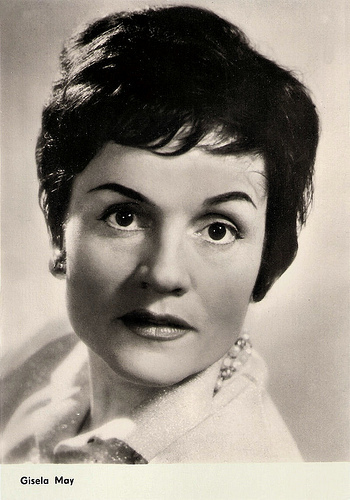
East-German postcard by VEB Progress Filmvertrieb, Berlin, no. 1684 1962. Photo: Georg Meyer-Hanno.
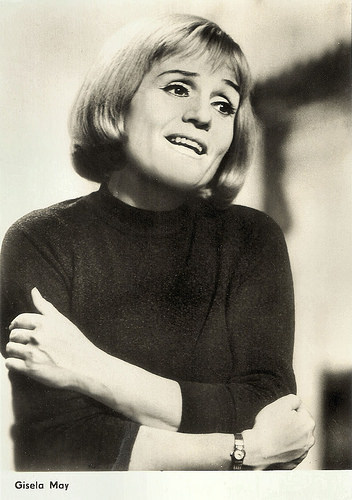
East-German postcard by VEB Progress Filmvertrieb, Berlin, no. 3318, 1968. Photo: Winkler.
A Hidden Gem
Gisela May was born, in Wetzlar, Germany, in 1924. She was the daughter of author Ferdinand May and actress Käte May. Between 1942 and 1944, May studied at the drama school in Leipzig.
She was employed for nine years at various theatres, including the State Theatre of Schwerin and the State Theatre in Halle. Starting in 1951, she performed at the Deutsches Theater in Berlin, Max Reinhardt's former workplace, where she played a variety of roles.
In 1962, May moved to Bertolt Brecht's theatre group, the Berliner Ensemble, and stayed for 30 years. While there she played a variety of roles in Brecht’s plays, including Madame Cabet in Die Tage der Commune/The Days of the Commune, Mrs Peachum in Die Dreigroschenoper/The Threepenny Opera, Mrs Kopecka in Schweyk im Zweiten Weltkrieg/Schweik in the Second World War, and as Mother Courage in Mutter Courage und ihre Kinder/Mother Courage in Mother Courage and Her Children, her most famous role, which she played for 13 years.
She also worked as a ‘diseuse’ with Austrian composer Hanns Eisler on a programme with chansons, political songs and poems. Later she appeared on the Berlin stage in the musicals Hallo Dolly!/Hello Dolly and Cabaret.
Since 1951, Gisela May appeared in dozens of East-German films and TV productions. She made her film debut in the drama Das Beil von Wandsbek/The Axe of Wandsbek (Falk Harnack, 1951), starring Erwin Geschonneck and Käthe Braun. At IMDb , all the reviewers consider this film as a hidden gem. Reviewer Hasosch: “I consider Dr. Falk Harnack's "Das Beil Von Wandsbek", together with "Obchod Na Korze/The Shop On Main Street" by Jan Kadar, and "Der Verlorene" by and with Peter Lorre as a Triptychon of the best World War II movies. (...) This movie belongs without doubt to the greatest rediscoveries in film history. After having watched it, you will not be the same anymore.”
Other interesting DEFA productions with May are the crime film Treffpunkt Aimée/Meeting Point Aimée (Horst Reinecke, 1956), the forbidden film Die Schönste/The Most Beautiful (Walter Beck, 1957/2002) with Manfred Krug, and Eine alte Liebe/An Old Love (Frank Beyer, 1959), in which she played her first leading part in the cinema.
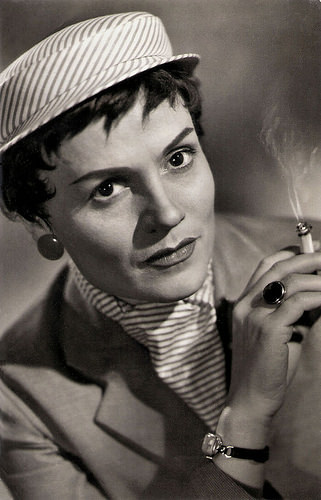
East-German postcard by VEB Progress Filmvertrieb, Berlin, no. 329/182, 1956. Photo: DEFA / Kroiss.
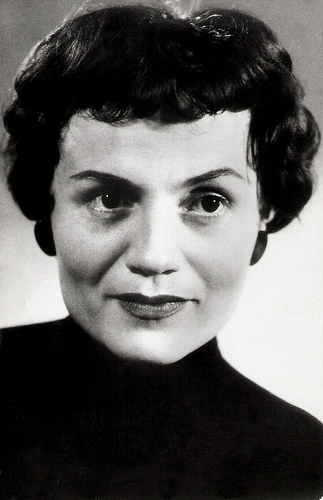
East-German postcard by VEB Progress Filmvertrieb, Berlin, no. 214/56, 1956. Photo: Georg Meyer-Hanno.
The times are changing
During the 1960s and and 1970s, Gisela May mostly worked for television and the stage. Among her few film appearances was Fleur Lafontaine (Horst Seemann, 1978), in which she played the mother of the title figure played by Angelica Domröse . She also appeared in the Hungarian film Csak egy mozi/Just a movie (Pal Sandor, 1985) with Jean-Pierre Léaud.
Gisela May won many awards for her work during the GDR period, but also afterwards. In 1991 she got the Deutscher Filmpreis in Gold (major German Film Award) for her role as Maika in the film Die Hallo-Sisters (Ottokar Runze, 1990). She shared the award with her co-stars in the film, Harald Juhnke and Ilse Werner . They play a run-down former radio producer and two quarrelsome 1950s stars who try their comeback on nationwide television.
Later films include the Greek production O Tzonys Keln, kyria mou/Johnny Keln, Madam (Thanassis Scroubelos, 1991) and the French-German drama Le silence du Coeur/The silence of the heart (Pierre Aknine, 1994) with Claude Piéplu.
Since 1992, May has free-lanced, often working at Berlin's Renaissance Theatre. May was able to pursue her career as a diseuse on an international basis, touring through Europe, Australia and the United States. She also appeared in 65 episodes of the TV Krimi-comedy Adelheid und ihre Mörder (1993-2007) featuring Evelyn Hamman. Since 2000, she regularly performs the show Gisela May singt und spricht Kurt Weill at the Berliner Ensemble.
In 2002 she was awarded with the Bundesverdienstkreuz (Federal Cross of Merit), the only federal decoration of Germany. That year, she also published her memoir Es wechseln die Zeiten (The times are changing). She also held master classes and workshops in German on Brechtian theatre and cabaret performance. From 1956 till 1965 Gisela May was married to journalist Georg Honigmann and later she lived together with Wolfgang Harich. Today, she lives in a senior home, but she is still active and incidentally performs on stage.
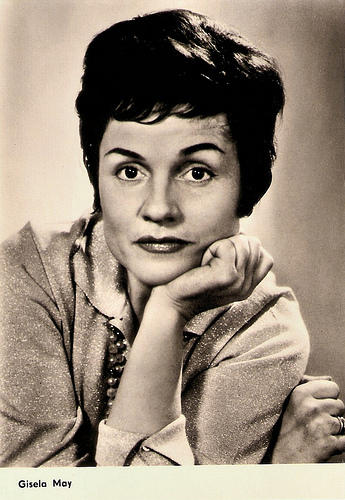
East-German postcard by VEB Progress Filmvertrieb, Berlin, no. 1777, 1962. Photo: Georg Meyer-Hanno.
Gisela May sings Seeräuberjenny/Pirate Jenny from Die Dreigroschenoper/The Threepenny Opera. Source: Vaimusic (YouTube).
Sources: Uncle Dave Lewis (AllMusic), Gisela May homepage (German), Akademie der Künste (German), Marian Buijs (De Volkskrant - Dutch), Wikipedia (German and English), and .

East-German postcard by VEB Progress Filmvertrieb, Berlin, no. 1684 1962. Photo: Georg Meyer-Hanno.

East-German postcard by VEB Progress Filmvertrieb, Berlin, no. 3318, 1968. Photo: Winkler.
A Hidden Gem
Gisela May was born, in Wetzlar, Germany, in 1924. She was the daughter of author Ferdinand May and actress Käte May. Between 1942 and 1944, May studied at the drama school in Leipzig.
She was employed for nine years at various theatres, including the State Theatre of Schwerin and the State Theatre in Halle. Starting in 1951, she performed at the Deutsches Theater in Berlin, Max Reinhardt's former workplace, where she played a variety of roles.
In 1962, May moved to Bertolt Brecht's theatre group, the Berliner Ensemble, and stayed for 30 years. While there she played a variety of roles in Brecht’s plays, including Madame Cabet in Die Tage der Commune/The Days of the Commune, Mrs Peachum in Die Dreigroschenoper/The Threepenny Opera, Mrs Kopecka in Schweyk im Zweiten Weltkrieg/Schweik in the Second World War, and as Mother Courage in Mutter Courage und ihre Kinder/Mother Courage in Mother Courage and Her Children, her most famous role, which she played for 13 years.
She also worked as a ‘diseuse’ with Austrian composer Hanns Eisler on a programme with chansons, political songs and poems. Later she appeared on the Berlin stage in the musicals Hallo Dolly!/Hello Dolly and Cabaret.
Since 1951, Gisela May appeared in dozens of East-German films and TV productions. She made her film debut in the drama Das Beil von Wandsbek/The Axe of Wandsbek (Falk Harnack, 1951), starring Erwin Geschonneck and Käthe Braun. At IMDb , all the reviewers consider this film as a hidden gem. Reviewer Hasosch: “I consider Dr. Falk Harnack's "Das Beil Von Wandsbek", together with "Obchod Na Korze/The Shop On Main Street" by Jan Kadar, and "Der Verlorene" by and with Peter Lorre as a Triptychon of the best World War II movies. (...) This movie belongs without doubt to the greatest rediscoveries in film history. After having watched it, you will not be the same anymore.”
Other interesting DEFA productions with May are the crime film Treffpunkt Aimée/Meeting Point Aimée (Horst Reinecke, 1956), the forbidden film Die Schönste/The Most Beautiful (Walter Beck, 1957/2002) with Manfred Krug, and Eine alte Liebe/An Old Love (Frank Beyer, 1959), in which she played her first leading part in the cinema.

East-German postcard by VEB Progress Filmvertrieb, Berlin, no. 329/182, 1956. Photo: DEFA / Kroiss.

East-German postcard by VEB Progress Filmvertrieb, Berlin, no. 214/56, 1956. Photo: Georg Meyer-Hanno.
The times are changing
During the 1960s and and 1970s, Gisela May mostly worked for television and the stage. Among her few film appearances was Fleur Lafontaine (Horst Seemann, 1978), in which she played the mother of the title figure played by Angelica Domröse . She also appeared in the Hungarian film Csak egy mozi/Just a movie (Pal Sandor, 1985) with Jean-Pierre Léaud.
Gisela May won many awards for her work during the GDR period, but also afterwards. In 1991 she got the Deutscher Filmpreis in Gold (major German Film Award) for her role as Maika in the film Die Hallo-Sisters (Ottokar Runze, 1990). She shared the award with her co-stars in the film, Harald Juhnke and Ilse Werner . They play a run-down former radio producer and two quarrelsome 1950s stars who try their comeback on nationwide television.
Later films include the Greek production O Tzonys Keln, kyria mou/Johnny Keln, Madam (Thanassis Scroubelos, 1991) and the French-German drama Le silence du Coeur/The silence of the heart (Pierre Aknine, 1994) with Claude Piéplu.
Since 1992, May has free-lanced, often working at Berlin's Renaissance Theatre. May was able to pursue her career as a diseuse on an international basis, touring through Europe, Australia and the United States. She also appeared in 65 episodes of the TV Krimi-comedy Adelheid und ihre Mörder (1993-2007) featuring Evelyn Hamman. Since 2000, she regularly performs the show Gisela May singt und spricht Kurt Weill at the Berliner Ensemble.
In 2002 she was awarded with the Bundesverdienstkreuz (Federal Cross of Merit), the only federal decoration of Germany. That year, she also published her memoir Es wechseln die Zeiten (The times are changing). She also held master classes and workshops in German on Brechtian theatre and cabaret performance. From 1956 till 1965 Gisela May was married to journalist Georg Honigmann and later she lived together with Wolfgang Harich. Today, she lives in a senior home, but she is still active and incidentally performs on stage.

East-German postcard by VEB Progress Filmvertrieb, Berlin, no. 1777, 1962. Photo: Georg Meyer-Hanno.
Gisela May sings Seeräuberjenny/Pirate Jenny from Die Dreigroschenoper/The Threepenny Opera. Source: Vaimusic (YouTube).
Sources: Uncle Dave Lewis (AllMusic), Gisela May homepage (German), Akademie der Künste (German), Marian Buijs (De Volkskrant - Dutch), Wikipedia (German and English), and .
Published on May 21, 2016 22:00
May 20, 2016
George Robey
George Robey (1869-1954) was an English comedian, singer and actor in musical theatre, who became known as one of the greatest music hall performers of the late 19th and early 20th centuries. As a comedian, Robey mixed everyday situations and observations with comic absurdity. Apart from his music hall acts, he was a popular Christmas pantomime performer in the English provinces, where he excelled in the dame roles. He only had modest success in the cinema.
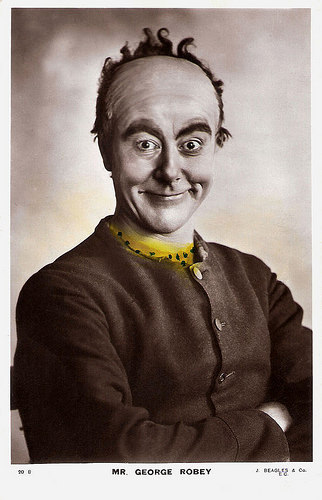
British postcard in the Rotary Photographic Series by Rotary Photo EC., no. 125 H.
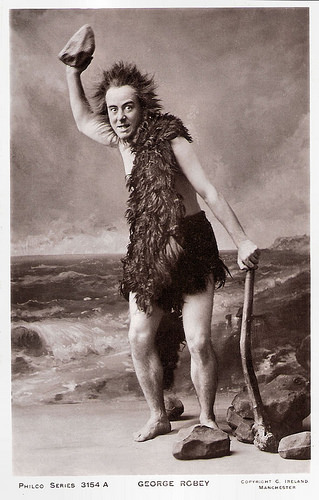
British postcard in the Philco Series by Rotary Photo EC., no. 3154 A. Photo: C. Ireland, Manchester. In 1902 Robey created the character The Prehistoric Man. He dressed as a caveman and spoke of modern political issues, often complaining about the government "slapping another pound of rock on his taxes". The character was received favourably by audiences, who found it easy to relate to his topical observations. That year he released The Prehistoric Man on a shellac disc using the early acoustic recording process.
The Prime Minister of Mirth
George Robey was born as George Edward Wade in London in 1869. He came from a middle-class family. His father, Charles Wade, was a civil engineer who spent much of his career on tramline design and construction. Robey's mother, Elizabeth Mary Wade née Keene, was a housewife.
After schooling in England and Germany, and a series of office jobs, he made his debut on the London stage, at the age of 21, as the straight man to a comic hypnotist. He soon developed his own act and appeared at the Oxford Music Hall in 1890, where he earned favourable notices singing The Simple Pimple and He'll Get It Where He's Gone to Now.
In 1892, Robey appeared in his first pantomime, Whittington Up-to-date in Brighton, which brought him to a wider audience. With Robey's popularity came an eagerness to differentiate himself from his music hall rivals, and so he devised a signature costume when appearing as himself: an oversized black coat fastened from the neck down with large, wooden buttons; black, unkempt, baggy trousers and a partially bald wig with black, whispery strands of unbrushed, dirty-looking hair that poked below a large, dishevelled top-hat. He applied thick white face paint and exaggerated the redness on his cheeks and nose with bright red make-up; his eye line and eyebrows were also enhanced with thick, black greasepaint. He held a short, misshaped, wooden walking stick, which was curved at the top.
Robey later used the costume for his character, The Prime Minister of Mirth. The outfit helped Robey become instantly recognisable on the London music hall circuit. More provincial engagements followed in Manchester, Birmingham and Liverpool, and he soon became a mainstay of the popular Christmas pantomime scene. By the start of the new century, Robey was a big name in pantomime, and he was able to choose his roles. Pantomime enjoyed wide popularity until the 1890s, but by the time Robey had reached his peak, interest in it was on the wane. A type of character he particularly enjoyed taking on was the pantomime dame, which historically was played by comedians from the music hall. Robey was inspired by the older comedians Herbert Campbell and Dan Leno , and, although post-dating them, he rivalled their eccentricity and popularity, earning the festive entertainment a new audience.
Robey's music hall act matured in the first decade of the 1900s, and he undertook a number of foreign tours. He starred in the Royal Command Performance in 1912 and regularly entertained before aristocracy. Robey had made his film debut in 1900, according to IMDb . The short comedy The Rats (N.N., 1900) offered a brief glimpse of some of the greatest entertainers from the late Victorian and early Edwardian stage, including Dan Leno , Herbert Campbell and George Robey. In 1913, Robey appeared in two early sound shorts: And Very Nice Too (Walter R. Boots, 1913) and Good Queen Bess (Walter R. Boots, 1913), made in the Kinoplasticon process, where the film was synchronised with phonograph records.
The next year, he tried to emulate his music hall colleagues Billy Merson and Charlie Austin, who had set up Homeland Films and found success with the Squibs series of films starring Betty Balfour . Robey met filmmakers from the Burns Film Company, who engaged him in a silent short entitled George Robey Turns Anarchist, in which he played a character who fails to blow up the Houses of Parliament. George Robey's Day Off (1919) showed the comedian acting out his daily domestic routines to comic effect, but the picture failed at the box office. Producers obviously did not know how best to apply Robey's stage talents to film. He continued to appear sporadically in film throughout the rest of his career, never achieving more than a modest amount of success.
By the First World War, music hall entertainment had fallen out of favour with audiences. Revue appealed to wartime audiences, and Robey decided to capitalise on the medium's popularity. He achieved great success in The Bing Boys Are Here (1916). He was cast as Lucius Bing opposite Violet Loraine, who played his love interest Emma. The couple duetted in the show's signature song If You Were the Only Girl (In the World), which became an international success. Robey raised money for many war charities and was appointed a CBE in 1919. From 1918, he created sketches based on his Prime Minister of Mirth character and used a costume he had designed in the 1890s as a basis for the character's attire.
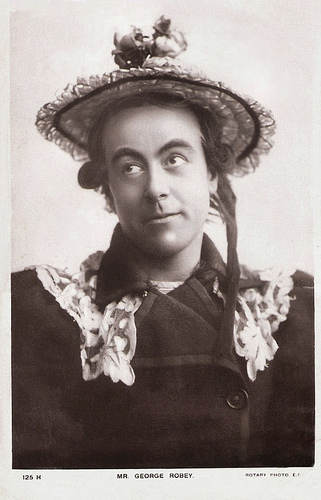
British postcard in the Rotary Photographic Series by Rotary Photo EC., no. 125 H.
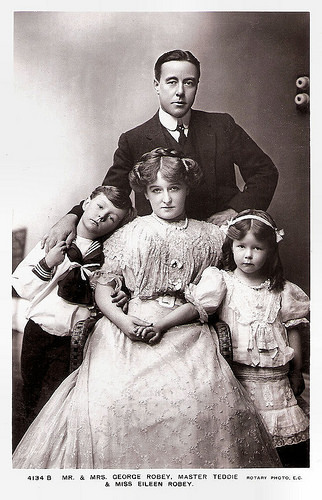
British postcard in the Rotary Photographic Series by Rotary Photo EC., no. 4134 B. Mr. and Mrs. George Robey, Master Teddie & Miss Eileen Robey.
Sancho Panza
George Robey starred in the revue Round in Fifty in 1922, which earned him still wider notice. He returned to the cinema a further four times during 1923. The first two films were written with the intention of showcasing his pantomime talents: One Arabian Night (Sinclair Hall, 1923) was a reworking of Aladdin and co-starred Lionelle Howard and Edward O'Neill. In Harlequinade (A.E. Coleby, 1923) visited the roots of pantomime.
One of Robey's more notable film roles was Sancho Panza in Don Quixote (Maurice Elvey, 1923), for which he received a fee of £700 a week. The amount of time he spent working away from home led to the breakdown of his marriage, and he separated from Ethel in 1923. With the exception of his performances in revue and pantomime, he appeared as his Prime Minister of Mirth character in all the other entertainment media including variety, music hall and radio.
In the late 1920s Robey wrote and starred in two Phonofilm sound-on-film productions, Safety First (Hugh Croise, 1928) and Mrs. Mephistopheles (Hugh Croise, 1929). In 1932 Robey appeared in his first sound film, The Temperance Fête (Graham Cutts, 1932). It was followed by Marry Me (Wilhelm Thiele, 1932), starring German actress Renate Müller , which was one of the most successful musical films of his career. The film tells the story of a sound recordist in a gramophone company who romances a colleague when she becomes the family housekeeper.
Robey continued to perform in variety theatre in the inter-war years and, in 1932, he starred in Helen!, his first straight theatre role. His appearance brought him to the attention of many influential directors, including Sydney Carroll, who signed him to appear on stage as Falstaff in Henry IV, Part 1 in 1935, a role that he later repeated in Laurence Olivier's film, Henry V (1944).
Robey starred opposite Fritz Kortner and Anna May Wong in a film version of the hit musical Chu Chin Chow (Walter Forde, 1934). The New York Times called him "a lovable and laughable Ali Baba". In the summer of 1938 Robey appeared in the film A Girl Must Live (Carol Reed, 1939) in which he played the role of Horace Blount. A journalist for The Times opined that Robey's performance as an elderly furrier, the love interest of both Margaret Lockwood and Lilli Palmer , was "a perfect study in bewildered embarrassment".
During the Second World War, Robey raised money for charities and promoted recruitment into the forces. Robey starred in the film Salute John Citizen (Maurice Elvey, 1942), co-starring Edward Rigby and Stanley Holloway, about the effects that the war had on a normal British family. A further four films followed in 1943, one of which promoted war propaganda while the other two displayed the popular medium of cine-variety.
By the 1950s, his health had deteriorated, and he entered into semi-retirement. George Robey was knighted a few months before his death at his home in Saltdean, East Sussex, in 1954. He was 85. Robey was married twice. In 1898, Robey married his first wife, the Australian-born musical theatre actress Ethel Hayden. Ethel accompanied him on his tours and frequently starred alongside him. They had two children, son Edward (1900) and daughter Eileen. After his divorce from Ethel in 1938, he married Blanche Littler, who was more than two decades his junior.
Violet Lorraine and George Robey sing If You Were The Only Girl In The World (1916). Source: gihiuh fvjjojo (YouTube).
George Robey and Thelma Tuson sing Any Time is Kissing Time in Chu Chin Chow (1934). Source:
Sources: Wikipedia and .

British postcard in the Rotary Photographic Series by Rotary Photo EC., no. 125 H.

British postcard in the Philco Series by Rotary Photo EC., no. 3154 A. Photo: C. Ireland, Manchester. In 1902 Robey created the character The Prehistoric Man. He dressed as a caveman and spoke of modern political issues, often complaining about the government "slapping another pound of rock on his taxes". The character was received favourably by audiences, who found it easy to relate to his topical observations. That year he released The Prehistoric Man on a shellac disc using the early acoustic recording process.
The Prime Minister of Mirth
George Robey was born as George Edward Wade in London in 1869. He came from a middle-class family. His father, Charles Wade, was a civil engineer who spent much of his career on tramline design and construction. Robey's mother, Elizabeth Mary Wade née Keene, was a housewife.
After schooling in England and Germany, and a series of office jobs, he made his debut on the London stage, at the age of 21, as the straight man to a comic hypnotist. He soon developed his own act and appeared at the Oxford Music Hall in 1890, where he earned favourable notices singing The Simple Pimple and He'll Get It Where He's Gone to Now.
In 1892, Robey appeared in his first pantomime, Whittington Up-to-date in Brighton, which brought him to a wider audience. With Robey's popularity came an eagerness to differentiate himself from his music hall rivals, and so he devised a signature costume when appearing as himself: an oversized black coat fastened from the neck down with large, wooden buttons; black, unkempt, baggy trousers and a partially bald wig with black, whispery strands of unbrushed, dirty-looking hair that poked below a large, dishevelled top-hat. He applied thick white face paint and exaggerated the redness on his cheeks and nose with bright red make-up; his eye line and eyebrows were also enhanced with thick, black greasepaint. He held a short, misshaped, wooden walking stick, which was curved at the top.
Robey later used the costume for his character, The Prime Minister of Mirth. The outfit helped Robey become instantly recognisable on the London music hall circuit. More provincial engagements followed in Manchester, Birmingham and Liverpool, and he soon became a mainstay of the popular Christmas pantomime scene. By the start of the new century, Robey was a big name in pantomime, and he was able to choose his roles. Pantomime enjoyed wide popularity until the 1890s, but by the time Robey had reached his peak, interest in it was on the wane. A type of character he particularly enjoyed taking on was the pantomime dame, which historically was played by comedians from the music hall. Robey was inspired by the older comedians Herbert Campbell and Dan Leno , and, although post-dating them, he rivalled their eccentricity and popularity, earning the festive entertainment a new audience.
Robey's music hall act matured in the first decade of the 1900s, and he undertook a number of foreign tours. He starred in the Royal Command Performance in 1912 and regularly entertained before aristocracy. Robey had made his film debut in 1900, according to IMDb . The short comedy The Rats (N.N., 1900) offered a brief glimpse of some of the greatest entertainers from the late Victorian and early Edwardian stage, including Dan Leno , Herbert Campbell and George Robey. In 1913, Robey appeared in two early sound shorts: And Very Nice Too (Walter R. Boots, 1913) and Good Queen Bess (Walter R. Boots, 1913), made in the Kinoplasticon process, where the film was synchronised with phonograph records.
The next year, he tried to emulate his music hall colleagues Billy Merson and Charlie Austin, who had set up Homeland Films and found success with the Squibs series of films starring Betty Balfour . Robey met filmmakers from the Burns Film Company, who engaged him in a silent short entitled George Robey Turns Anarchist, in which he played a character who fails to blow up the Houses of Parliament. George Robey's Day Off (1919) showed the comedian acting out his daily domestic routines to comic effect, but the picture failed at the box office. Producers obviously did not know how best to apply Robey's stage talents to film. He continued to appear sporadically in film throughout the rest of his career, never achieving more than a modest amount of success.
By the First World War, music hall entertainment had fallen out of favour with audiences. Revue appealed to wartime audiences, and Robey decided to capitalise on the medium's popularity. He achieved great success in The Bing Boys Are Here (1916). He was cast as Lucius Bing opposite Violet Loraine, who played his love interest Emma. The couple duetted in the show's signature song If You Were the Only Girl (In the World), which became an international success. Robey raised money for many war charities and was appointed a CBE in 1919. From 1918, he created sketches based on his Prime Minister of Mirth character and used a costume he had designed in the 1890s as a basis for the character's attire.

British postcard in the Rotary Photographic Series by Rotary Photo EC., no. 125 H.

British postcard in the Rotary Photographic Series by Rotary Photo EC., no. 4134 B. Mr. and Mrs. George Robey, Master Teddie & Miss Eileen Robey.
Sancho Panza
George Robey starred in the revue Round in Fifty in 1922, which earned him still wider notice. He returned to the cinema a further four times during 1923. The first two films were written with the intention of showcasing his pantomime talents: One Arabian Night (Sinclair Hall, 1923) was a reworking of Aladdin and co-starred Lionelle Howard and Edward O'Neill. In Harlequinade (A.E. Coleby, 1923) visited the roots of pantomime.
One of Robey's more notable film roles was Sancho Panza in Don Quixote (Maurice Elvey, 1923), for which he received a fee of £700 a week. The amount of time he spent working away from home led to the breakdown of his marriage, and he separated from Ethel in 1923. With the exception of his performances in revue and pantomime, he appeared as his Prime Minister of Mirth character in all the other entertainment media including variety, music hall and radio.
In the late 1920s Robey wrote and starred in two Phonofilm sound-on-film productions, Safety First (Hugh Croise, 1928) and Mrs. Mephistopheles (Hugh Croise, 1929). In 1932 Robey appeared in his first sound film, The Temperance Fête (Graham Cutts, 1932). It was followed by Marry Me (Wilhelm Thiele, 1932), starring German actress Renate Müller , which was one of the most successful musical films of his career. The film tells the story of a sound recordist in a gramophone company who romances a colleague when she becomes the family housekeeper.
Robey continued to perform in variety theatre in the inter-war years and, in 1932, he starred in Helen!, his first straight theatre role. His appearance brought him to the attention of many influential directors, including Sydney Carroll, who signed him to appear on stage as Falstaff in Henry IV, Part 1 in 1935, a role that he later repeated in Laurence Olivier's film, Henry V (1944).
Robey starred opposite Fritz Kortner and Anna May Wong in a film version of the hit musical Chu Chin Chow (Walter Forde, 1934). The New York Times called him "a lovable and laughable Ali Baba". In the summer of 1938 Robey appeared in the film A Girl Must Live (Carol Reed, 1939) in which he played the role of Horace Blount. A journalist for The Times opined that Robey's performance as an elderly furrier, the love interest of both Margaret Lockwood and Lilli Palmer , was "a perfect study in bewildered embarrassment".
During the Second World War, Robey raised money for charities and promoted recruitment into the forces. Robey starred in the film Salute John Citizen (Maurice Elvey, 1942), co-starring Edward Rigby and Stanley Holloway, about the effects that the war had on a normal British family. A further four films followed in 1943, one of which promoted war propaganda while the other two displayed the popular medium of cine-variety.
By the 1950s, his health had deteriorated, and he entered into semi-retirement. George Robey was knighted a few months before his death at his home in Saltdean, East Sussex, in 1954. He was 85. Robey was married twice. In 1898, Robey married his first wife, the Australian-born musical theatre actress Ethel Hayden. Ethel accompanied him on his tours and frequently starred alongside him. They had two children, son Edward (1900) and daughter Eileen. After his divorce from Ethel in 1938, he married Blanche Littler, who was more than two decades his junior.
Violet Lorraine and George Robey sing If You Were The Only Girl In The World (1916). Source: gihiuh fvjjojo (YouTube).
George Robey and Thelma Tuson sing Any Time is Kissing Time in Chu Chin Chow (1934). Source:
Sources: Wikipedia and .
Published on May 20, 2016 22:00
May 19, 2016
EFSP's Dazzling Dozen: Dance, Girl, Dance!
In the early 20th Century, dance became one of the most exciting performing arts. Les Ballets Russes, which performed between 1909 and 1929 throughout Europe and on tours to North and South America, would change global ballet forever. In Germany, Die Ausdruckstanz, the expressionistic dance, caused another revolution. Die Ausdruckstanz arose in 1900 as a protest against the artistic stagnation of classical ballet. This new dance was freer, natural and less rule-governed. It was strongly influenced by the passage of the expressionistic visual arts. Today twelve postcards from Didier Hanson's wonderful collection presenting innovating dancers who also performed in the silent cinema.
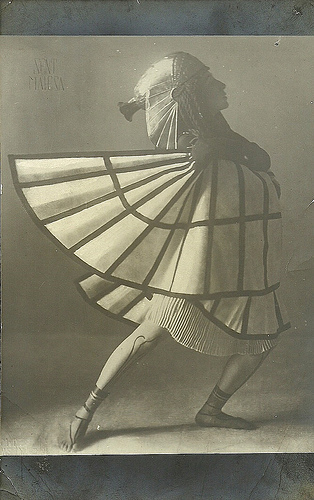
Vintage postcard. Photo: Hanns Holdt. Collection: Didier Hanson.
Sent M'Ahesa (1883-1970) was a famous performer of the Ausdruckstanz, the German expressionist dance. She was born as Else von Carlsberg in Riga and moved to Berlin in 1905. Her dances referred to the Egyptian antiquity and were known all over Europe. She was also known for the German silent films Die entschleierte Maja/The Naked Maja (Ludwig Beck, 1917) and Haß/Hate (Manfred Noa, 1920).
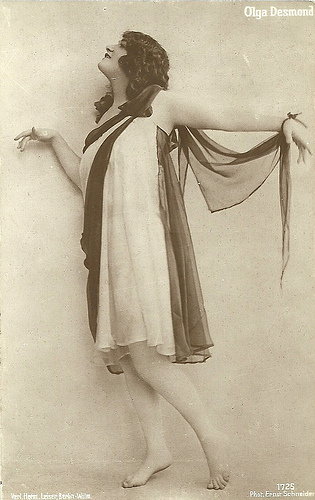
German postcard by Hermann Leiser, Berlin-Wilm., no 1725. Photo: Ernst Schneider. Collection: Didier Hanson.
Olga Desmond (1890-1964) was a German dancer and actress. Desmond was the 'heroine of living pictures' and became one of the first to promote nudity on the stage. From 1916 through 1919 she appeared in various films.
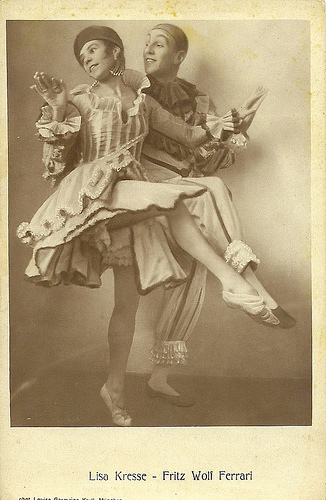
German postcard. Photo: Louise Germaine Krull, München. Collection: Didier Hanson.
Lisa Kresse was a dancer and actress, known for such silent films as Der Einäugige (Josef Coenen, 1916) with Carl Auen , Narr und Tod (Rudolf Stiaßny, 1920), Das Geheimnis des Buddha (Philipp Lothar Mayring, 1920) and Die Flammenfahrt des Pacific-Express (Philipp Lothar Mayring, 1921).
Dancer Fritz Wolf-Ferrari (1899-1971) was the son of composer and opera director Ermanno Wolf-Ferrari and soprano Clara Kilian. As Federico Wolf-Ferrari he became known as a stage director and manager.
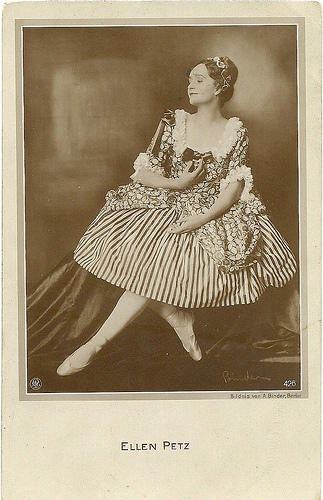
German postcard by NPG, no. 426. Photo: Alex Binder. Collection: Didier Hanson.
The actress and dancer Ellen Petz (1899-1970) was one of the main figures of the Ausdruckstanz in Germany. As a dancer Petz appeared on many stages. She belonged to the cofounders of the organisation Bund für Körperbildung e.V. 1917, which was dedicated to the dance. Ellen Petz also appeared in one silent film.
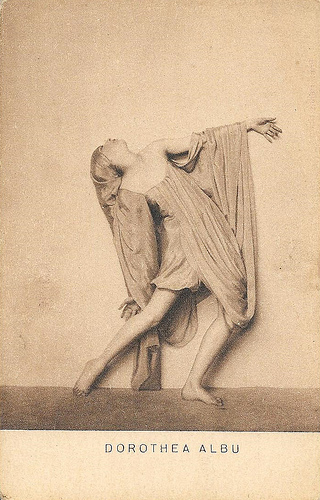
Vintage postcard. Publicity still for the stage production of Mata Hari (1922). Collection: Didier Hanson.
Dorothea Albu (1903-?) was one of the ballerinas of the Berlin State Opera ballet. In 1927, she danced in the film Mata Hari, die rote Tänzerin/Mata Hari: the Red Dancer (Friedrich Feher, 1927), featuring Magda Sonja .
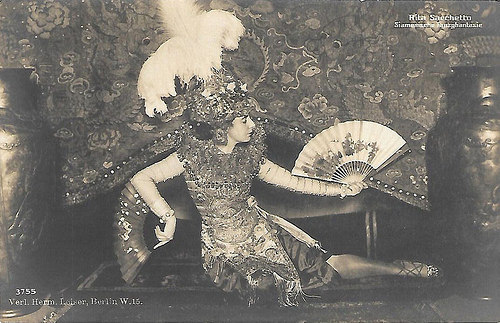
German Postcard by Verlag Hermann Leiser, Berlin, no. 3755. Photo: publicity still for the stage performance Siamesische Tanzphantasie. Collection: Didier Hanson.
German actress and dancer Rita Sacchetto (1879-1959) was in the 1910s a star of the Danish Nordisk Film Company.
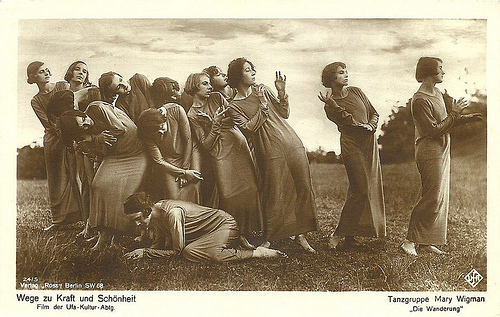
German postcard by Ross Verlag, Berlin, no. 24/5. Photo: Ufa. Publicity still for Wege zu Kraft und Schönheit/Ways to Strength and Beauty (Nicholas Kaufmann, Wilhelm Prager, 1925). Pictured are members of the Tanzgruppe Mary Wigman performing Die Wanderung (The Hike). Collection: Didier Hanson.
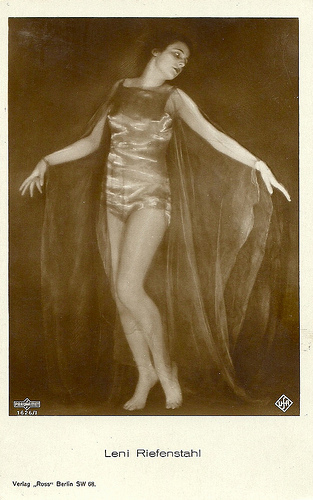
German postcard by Ross Verlag, no. 1626/1, 1927-1928. Photo: Ufa / Parufamet. Collection: Didier Hanson.
Before Leni Riefenstahl (1902-2003) started directing films, she worked as a dancer. On screen she became a star in the mountain films, directed by Arnold Fanck.
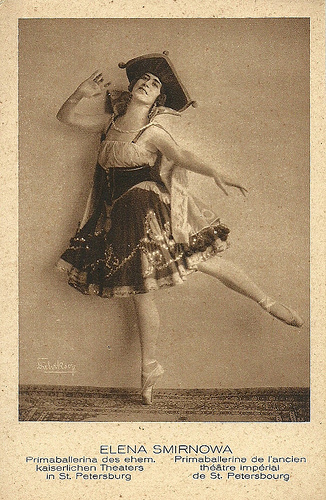
Vintage postcard. Collection: Didier Hanson.
Elena Aleksandrovna Smirnowa (1888-1934) was a famous Russian ballerina. She also appeared in the Russian silent cinema, most notably in Yevgeni Bauer's Child of the Big City (1914).
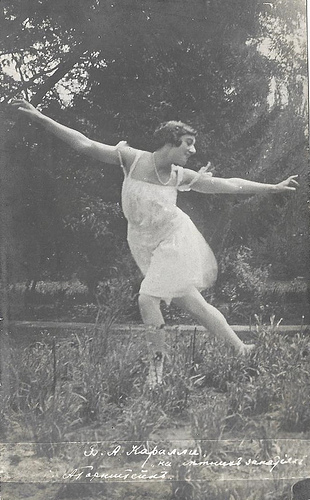
Russian postcard. Collection: Didier Hanson.
Vera Karalli (1889-1972) was a Russian ballet dancer, choreographer and actress in the early 20th century.
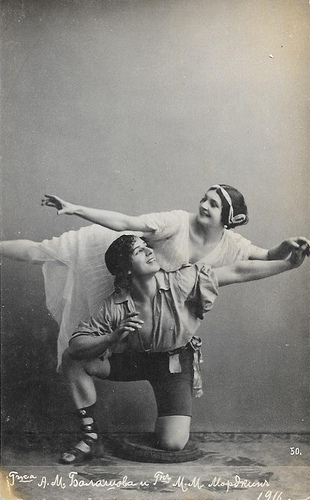
Alexandra Bashova and Mikhail Mordkin. Russian postcard, no. 30. Collection: Didier Hanson.
Mikhail Mordkin (1880-1944) graduated from the Bolshoi Ballet School in 1899, and in the same year was appointed ballet master. He joined Diaghilev's ballet in 1909 as a leading dancer and was appointed its director in 1917. In 1918 he appeared in the film Aziade (Joseph Soiffer, 1918). He left Russia after the October Revolution, first working in Lithuania, and finally settling in the United States in 1924.
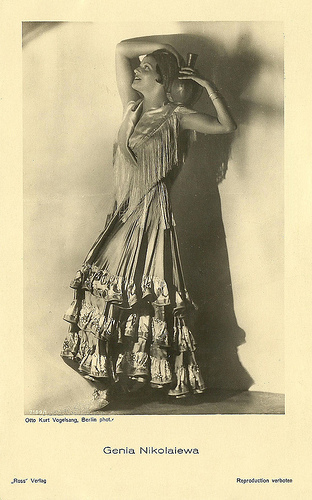
German postcard by Ross Verlag, no. 7189/1, 1932-1933. Photo: Otto Kurt Vogelsang, Berlin. Collection: Didier Hanson.
Russian-born ballet dancer and actress Genia Nikolaieva (1904–2001) danced in the ensemble of Ernst Matray , and with his company she gave guest performances in England and South America. She became one of the soloists at the Staatsoper ballet (State Opera Ballet) in Berlin and worked in the German cinema during the 1930s. In 1938 she emigrated to the United States, where she became ‘one of the most beautiful studio secretaries for Warner Bros’.
This is a post for Postcard Friendship Friday, hosted by Beth at the The Best Hearts are Crunchy. You can visit her by clicking on the button below.


Vintage postcard. Photo: Hanns Holdt. Collection: Didier Hanson.
Sent M'Ahesa (1883-1970) was a famous performer of the Ausdruckstanz, the German expressionist dance. She was born as Else von Carlsberg in Riga and moved to Berlin in 1905. Her dances referred to the Egyptian antiquity and were known all over Europe. She was also known for the German silent films Die entschleierte Maja/The Naked Maja (Ludwig Beck, 1917) and Haß/Hate (Manfred Noa, 1920).

German postcard by Hermann Leiser, Berlin-Wilm., no 1725. Photo: Ernst Schneider. Collection: Didier Hanson.
Olga Desmond (1890-1964) was a German dancer and actress. Desmond was the 'heroine of living pictures' and became one of the first to promote nudity on the stage. From 1916 through 1919 she appeared in various films.

German postcard. Photo: Louise Germaine Krull, München. Collection: Didier Hanson.
Lisa Kresse was a dancer and actress, known for such silent films as Der Einäugige (Josef Coenen, 1916) with Carl Auen , Narr und Tod (Rudolf Stiaßny, 1920), Das Geheimnis des Buddha (Philipp Lothar Mayring, 1920) and Die Flammenfahrt des Pacific-Express (Philipp Lothar Mayring, 1921).
Dancer Fritz Wolf-Ferrari (1899-1971) was the son of composer and opera director Ermanno Wolf-Ferrari and soprano Clara Kilian. As Federico Wolf-Ferrari he became known as a stage director and manager.

German postcard by NPG, no. 426. Photo: Alex Binder. Collection: Didier Hanson.
The actress and dancer Ellen Petz (1899-1970) was one of the main figures of the Ausdruckstanz in Germany. As a dancer Petz appeared on many stages. She belonged to the cofounders of the organisation Bund für Körperbildung e.V. 1917, which was dedicated to the dance. Ellen Petz also appeared in one silent film.

Vintage postcard. Publicity still for the stage production of Mata Hari (1922). Collection: Didier Hanson.
Dorothea Albu (1903-?) was one of the ballerinas of the Berlin State Opera ballet. In 1927, she danced in the film Mata Hari, die rote Tänzerin/Mata Hari: the Red Dancer (Friedrich Feher, 1927), featuring Magda Sonja .

German Postcard by Verlag Hermann Leiser, Berlin, no. 3755. Photo: publicity still for the stage performance Siamesische Tanzphantasie. Collection: Didier Hanson.
German actress and dancer Rita Sacchetto (1879-1959) was in the 1910s a star of the Danish Nordisk Film Company.

German postcard by Ross Verlag, Berlin, no. 24/5. Photo: Ufa. Publicity still for Wege zu Kraft und Schönheit/Ways to Strength and Beauty (Nicholas Kaufmann, Wilhelm Prager, 1925). Pictured are members of the Tanzgruppe Mary Wigman performing Die Wanderung (The Hike). Collection: Didier Hanson.

German postcard by Ross Verlag, no. 1626/1, 1927-1928. Photo: Ufa / Parufamet. Collection: Didier Hanson.
Before Leni Riefenstahl (1902-2003) started directing films, she worked as a dancer. On screen she became a star in the mountain films, directed by Arnold Fanck.

Vintage postcard. Collection: Didier Hanson.
Elena Aleksandrovna Smirnowa (1888-1934) was a famous Russian ballerina. She also appeared in the Russian silent cinema, most notably in Yevgeni Bauer's Child of the Big City (1914).

Russian postcard. Collection: Didier Hanson.
Vera Karalli (1889-1972) was a Russian ballet dancer, choreographer and actress in the early 20th century.

Alexandra Bashova and Mikhail Mordkin. Russian postcard, no. 30. Collection: Didier Hanson.
Mikhail Mordkin (1880-1944) graduated from the Bolshoi Ballet School in 1899, and in the same year was appointed ballet master. He joined Diaghilev's ballet in 1909 as a leading dancer and was appointed its director in 1917. In 1918 he appeared in the film Aziade (Joseph Soiffer, 1918). He left Russia after the October Revolution, first working in Lithuania, and finally settling in the United States in 1924.

German postcard by Ross Verlag, no. 7189/1, 1932-1933. Photo: Otto Kurt Vogelsang, Berlin. Collection: Didier Hanson.
Russian-born ballet dancer and actress Genia Nikolaieva (1904–2001) danced in the ensemble of Ernst Matray , and with his company she gave guest performances in England and South America. She became one of the soloists at the Staatsoper ballet (State Opera Ballet) in Berlin and worked in the German cinema during the 1930s. In 1938 she emigrated to the United States, where she became ‘one of the most beautiful studio secretaries for Warner Bros’.
This is a post for Postcard Friendship Friday, hosted by Beth at the The Best Hearts are Crunchy. You can visit her by clicking on the button below.

Published on May 19, 2016 22:00
May 18, 2016
Simone Renant
Beautiful French film and stage actress Simone Renant (1911–2004) appeared in 43 films between 1932 and 1980. The elegant blonde actress is best known for her roles in Quai des Orfèvres (1947) and the original French version of Dangerous Liasions, Les liaisons dangereuses (1959).
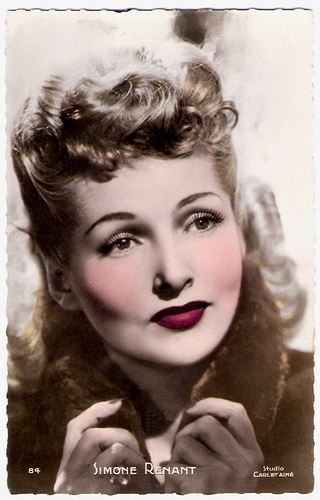
French postcard by Editions P.I., La Garenne-Colombes, no. 84. Photo: Studio Carlet Ainé.
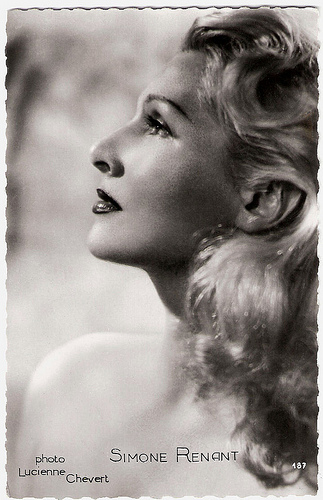
French postcard by Edit. P.I., no. 186, offered by Les Carbones Korès Photo: Lucienne Chevert.

French postcard by Edit. Chantal, Rueil, no. 10. Photo: Roger Richebé.
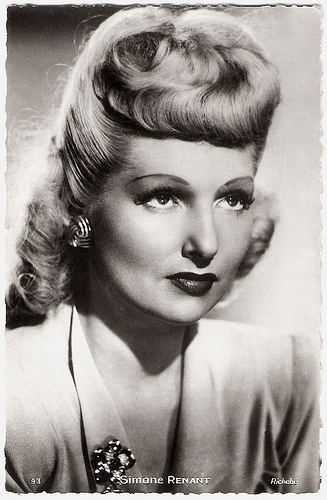
French postcard by E.C., Paris, no. 93. Photo: Roger Richebé.
Seductive and Elegant
Simone Renant was born Georgette Simone Alexine Buigny in Amiens, France, in 1911. She studied at the Conservatoire d'Amiens, then a part of the Conservatoire de Paris. There she won the First Prize.
She made her stage debut at the théâtre du Vieux Colombier. The seductive and elegant Renant first appeared in the cinema with Léon Poirier in La Folle nuit/The Crazy Night (Robert Bibal, 1932).
Director - and later husband - Christian-Jaque gave her her first bigger parts in L'Ecole des journalistes/School for Journalists (1936) with Armand Bernard , and Les Pirates du rail/The Railway Pirates (1937) with Charles Vanel and Erich von Stroheim .
During the Second World War, Renant maintained her vedette status in roles at coquettish and mannered women in Elles étaient douze femmes/They Were Twelve Women (Georges Lacombe, 1940) with Gaby Morlay , and Lettres d'amour/Love Letters (Claude Autant-Lara, 1942) with François Périer .
She also proved to be a charming and spirited comedienne in Romance à trois/Romance for Three (Roger Richebé, 1942), and Domino (Roger Richebé, 1943) both with Fernand Gravey , and in the romantic fantasy La Tentation de Barbizon/The Temptation of Barbizon (Jean Stelli, 1945) starring Daniel Gélin .
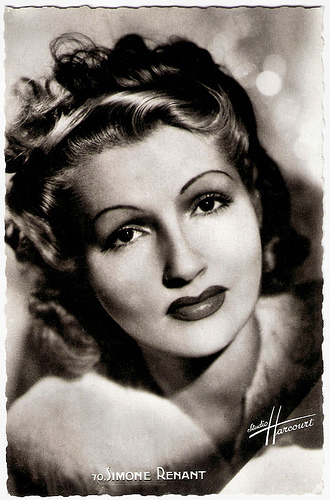
French postcard by S.E.R.P., Paris, no. 70. Photo: Studio Harcourt.
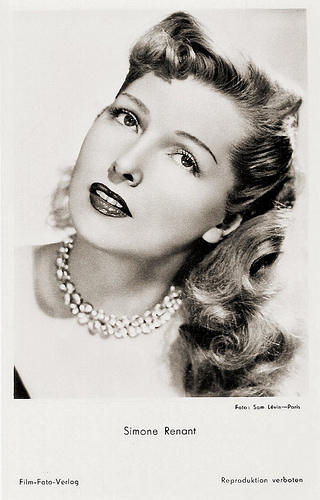
German postcard by Ufa/Film-Foto-Verlag, no. FK 475. Photo: Sam Lévin, Paris.
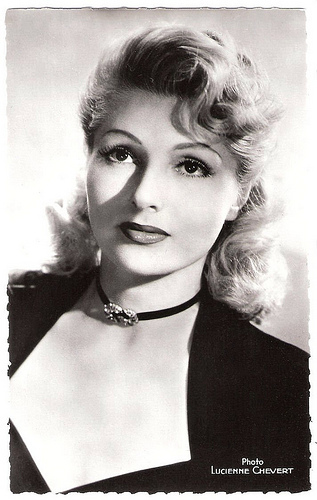
French postcard by Editions du Globe, no. 153. Photo: Lucienne Chevert.
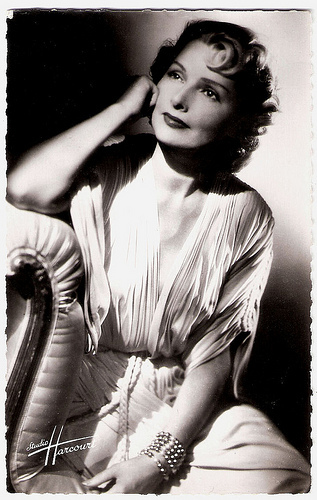
French postcard by Editions O.P., Paris, no. 80. Photo: Studio Harcourt.
Ambiguous and Melancholic Role
Against her image Simone Renant played an ambiguous and melancholic role in the classic thriller Quai des Orfèvres/Quay of the Goldsmiths (Henri-Georges Clouzot, 1947) opposite Suzy Delair . She plays the photographer Dora, who takes pictures of female models. In a subtle way Clouzot reveals us she's a lesbian. The police chief ( Louis Jouvet ) tells her: "You and me,WE are not lucky with women."
Since that beautiful performance her film appearances became rarer. She was very active in the theatre, and also appeared, though less frequently, on television.
In the cinema she appeared in Les liaisons dangereuses/Dangerous Liaisons (Roger Vadim, 1959) with Gérard Philipe and Jeanne Moreau , and she did a surprising turn as the owner of a gaming den in the Brazilian jungle in L'Homme de Rio/That Man from Rio (1963), starring Jean Paul Belmondo .
Her last film role was that of Alain Delon 's mother in the thriller Trois hommes à abattre/Three Men to Destroy (Jacques Deray, 1980). On TV she last appeared in Liberté-liberté/Freedom-Freedom (Alain Dhouailly, 1983) opposite Michael Lonsdale.
In 2004, Simone Renant died after a long illness in Garches, France, aged 93. She had been married four times. She married and divorced actor Marcel Dalio (1929-1932), Charles Gombault (1933-1937), and film director Christian-Jaque (1938-1940). In 1945 she married film producer and actor Alexandre Mnouchkine. The pair had two children and stayed together till his death in 1993.
Scene from La tentation de Barbizon (1946). Sorry, no subtitles. Source: FILMS CHRÉTIENS POUR TOUS (YouTube).
French trailer for Quai des Orfèvres/Quay of the Goldsmiths (1947). Source: Fludbis (Daily Motion).
French trailer of Les liaisons dangereuses/Dangerous Liaisons (1959). Source: kirivalse (Daily Motion).
Simone Renant as Lola, a woman controlling a riverside village in the heart of the Amazon, in L'Homme de Rio/That Man from Rio (1963), starring Jean Paul Belmondo . Source: shinhoshi (YouTube).
Sources: Ciné-Ressources (French), Wikipedia, and .

French postcard by Editions P.I., La Garenne-Colombes, no. 84. Photo: Studio Carlet Ainé.

French postcard by Edit. P.I., no. 186, offered by Les Carbones Korès Photo: Lucienne Chevert.

French postcard by Edit. Chantal, Rueil, no. 10. Photo: Roger Richebé.

French postcard by E.C., Paris, no. 93. Photo: Roger Richebé.
Seductive and Elegant
Simone Renant was born Georgette Simone Alexine Buigny in Amiens, France, in 1911. She studied at the Conservatoire d'Amiens, then a part of the Conservatoire de Paris. There she won the First Prize.
She made her stage debut at the théâtre du Vieux Colombier. The seductive and elegant Renant first appeared in the cinema with Léon Poirier in La Folle nuit/The Crazy Night (Robert Bibal, 1932).
Director - and later husband - Christian-Jaque gave her her first bigger parts in L'Ecole des journalistes/School for Journalists (1936) with Armand Bernard , and Les Pirates du rail/The Railway Pirates (1937) with Charles Vanel and Erich von Stroheim .
During the Second World War, Renant maintained her vedette status in roles at coquettish and mannered women in Elles étaient douze femmes/They Were Twelve Women (Georges Lacombe, 1940) with Gaby Morlay , and Lettres d'amour/Love Letters (Claude Autant-Lara, 1942) with François Périer .
She also proved to be a charming and spirited comedienne in Romance à trois/Romance for Three (Roger Richebé, 1942), and Domino (Roger Richebé, 1943) both with Fernand Gravey , and in the romantic fantasy La Tentation de Barbizon/The Temptation of Barbizon (Jean Stelli, 1945) starring Daniel Gélin .

French postcard by S.E.R.P., Paris, no. 70. Photo: Studio Harcourt.

German postcard by Ufa/Film-Foto-Verlag, no. FK 475. Photo: Sam Lévin, Paris.

French postcard by Editions du Globe, no. 153. Photo: Lucienne Chevert.

French postcard by Editions O.P., Paris, no. 80. Photo: Studio Harcourt.
Ambiguous and Melancholic Role
Against her image Simone Renant played an ambiguous and melancholic role in the classic thriller Quai des Orfèvres/Quay of the Goldsmiths (Henri-Georges Clouzot, 1947) opposite Suzy Delair . She plays the photographer Dora, who takes pictures of female models. In a subtle way Clouzot reveals us she's a lesbian. The police chief ( Louis Jouvet ) tells her: "You and me,WE are not lucky with women."
Since that beautiful performance her film appearances became rarer. She was very active in the theatre, and also appeared, though less frequently, on television.
In the cinema she appeared in Les liaisons dangereuses/Dangerous Liaisons (Roger Vadim, 1959) with Gérard Philipe and Jeanne Moreau , and she did a surprising turn as the owner of a gaming den in the Brazilian jungle in L'Homme de Rio/That Man from Rio (1963), starring Jean Paul Belmondo .
Her last film role was that of Alain Delon 's mother in the thriller Trois hommes à abattre/Three Men to Destroy (Jacques Deray, 1980). On TV she last appeared in Liberté-liberté/Freedom-Freedom (Alain Dhouailly, 1983) opposite Michael Lonsdale.
In 2004, Simone Renant died after a long illness in Garches, France, aged 93. She had been married four times. She married and divorced actor Marcel Dalio (1929-1932), Charles Gombault (1933-1937), and film director Christian-Jaque (1938-1940). In 1945 she married film producer and actor Alexandre Mnouchkine. The pair had two children and stayed together till his death in 1993.
Scene from La tentation de Barbizon (1946). Sorry, no subtitles. Source: FILMS CHRÉTIENS POUR TOUS (YouTube).
French trailer for Quai des Orfèvres/Quay of the Goldsmiths (1947). Source: Fludbis (Daily Motion).
French trailer of Les liaisons dangereuses/Dangerous Liaisons (1959). Source: kirivalse (Daily Motion).
Simone Renant as Lola, a woman controlling a riverside village in the heart of the Amazon, in L'Homme de Rio/That Man from Rio (1963), starring Jean Paul Belmondo . Source: shinhoshi (YouTube).
Sources: Ciné-Ressources (French), Wikipedia, and .
Published on May 18, 2016 22:00
May 17, 2016
Idillio tragico (1922)
The Italian silent film Idillio tragico (Gaston Ravel, 1922), based on the novel Idylle tragique (1896) by Paul Bourget. Star of this Medusa Film production was the beautiful Polish actress Helena (Elena) Makowska who was one of the divas of the Italian silent cinema in the 1910s.
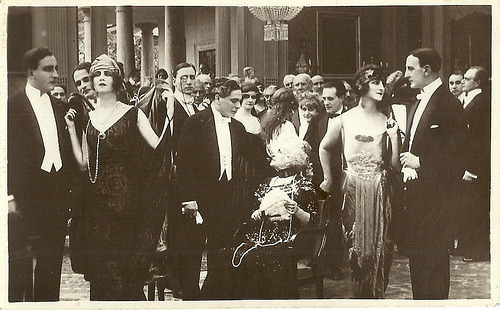
Italian postcard by Unione Cinematografica Italiana. Photo: publicity still for Idillio tragico (Gaston Ravel, 1922). Caption: An aristocratic reception.
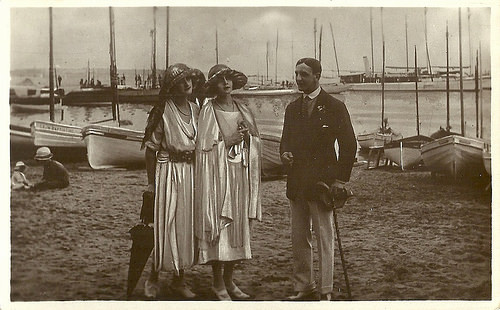
Italian postcard by Unione Cinematografica Italiana. Photo: publicity still for Idillio tragico (Gaston Ravel, 1922). Caption: Start of the idyll between Ely and Oliviero.
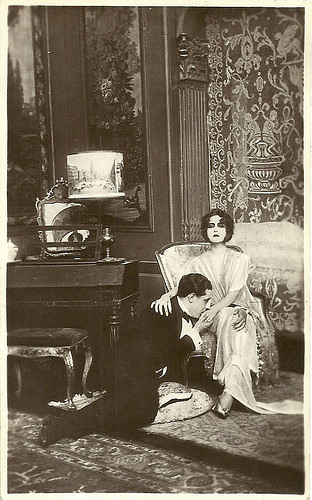
Italian postcard by Unione Cinematografica Italiana. Photo: publicity still for Idillio tragico (Gaston Ravel, 1922). Caption: Oliviero Duprat and Ely of Carlsberg in the first moments of their happiness.
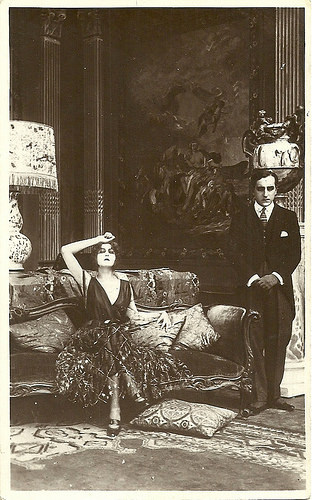
Italian postcard by Unione Cinematografica Italiana. Photo: publicity still for Idillio tragico (Gaston Ravel, 1922). Caption: Jealousy.
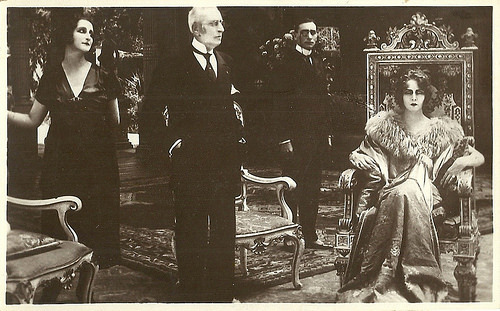
Italian postcard by Unione Cinematografica Italiana. Photo: publicity still for Idillio tragico (Gaston Ravel, 1922). Caption: Ely's sadness after Oliviero has abandoned her.
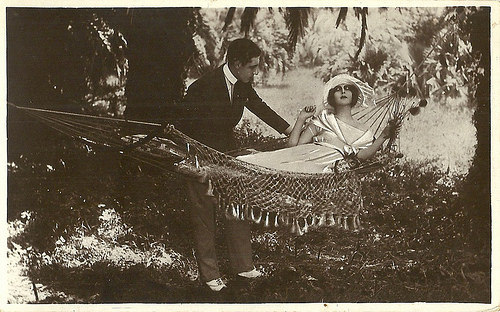
Italian postcard by Unione Cinematografica Italiana. Photo: publicity still for Idillio tragico (Gaston Ravel, 1922). Caption: In order to take revenge on Oliviero, Ely tries to have Pierre d'Hautefeuille fall in love with her.
The idyll that ends in blood
In Idillio tragico the old archduke Henri François (Cav. Giuseppe Piemontesi) tries to prevent the marriage between his assistent Marcel Verdier (Tony Lekain) and the American lady Miss Marsh (Dolly Morgan), afraid to lose his assistent.
His wife, baroness Eleonora/Ely/Elly von Carlsberg ( Helena Makowska ), however, helps the two young ones to crown their love. Tired of her husband's jealousy and insults, she starts an affair with Oliviero/Olivier Duprat (Guido Trento), attaché at the French Embassy, but in reality a cynic upstart who is soon maltreating Eleonora.
Instead his friend Pierre d' Hautefeuille (Ferruccio Lado) truly falls in love with Elly. Olivier wants his friend to break with her but Pierre wants to see her one last time.
The archduke, already sore because of the flight of his assistant, hears about his wife's infidelity and plans an ambush. When he notices a hitman is about to kill Pietro, Olivier shields his friend and dies. Elly and Pierre won't meet again. The idyll tragically ends in blood.
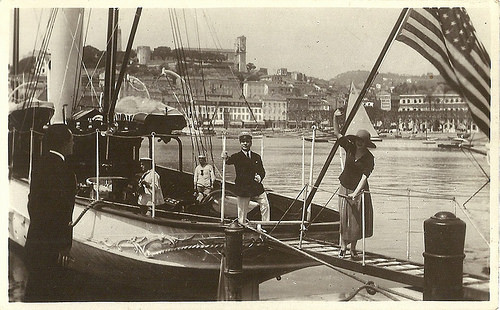
Italian postcard by Unione Cinematografica Italiana. Photo: publicity still for Idillio tragico (Gaston Ravel, 1922). Caption: Aboard the "Sita".
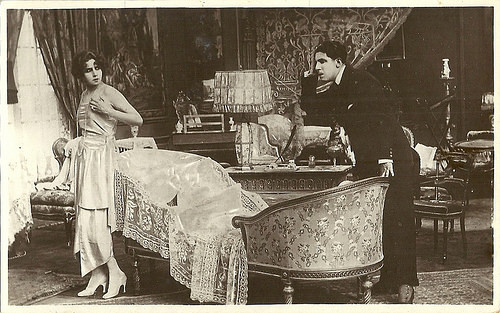
Italian postcard by Unione Cinematografica Italiana. Photo: publicity still for Idillio tragico (Gaston Ravel, 1922). Caption: Jealousy and suspicions by Olivier.
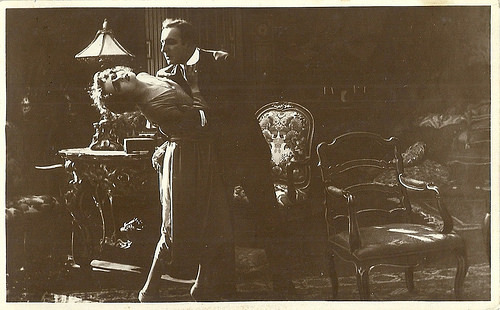
Italian postcard by Unione Cinematografica Italiana. Photo: publicity still for Idillio tragico (Gaston Ravel, 1922). Caption: Ely rejects Oliviero, as she has now fallen in love with Pietro di Hautefeuille.
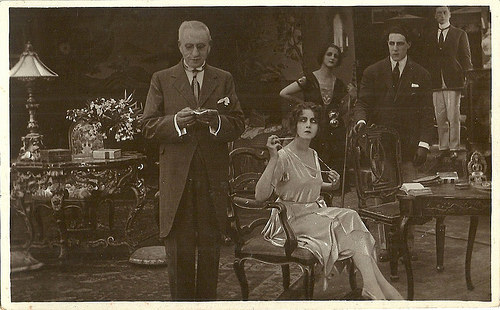
Italian postcard by Unione Cinematografica Italiana. Photo: publicity still for Idillio tragico (Gaston Ravel, 1922). Caption: The archduke Francesco has in his hands the proof of his wife's infidelity.
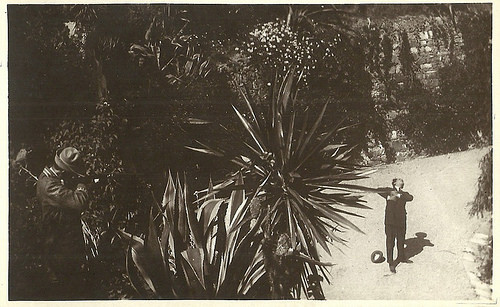
Italian postcard by Unione Cinematografica Italiana. Photo: publicity still for Idillio tragico (Gaston Ravel, 1922). Caption: Oliviero's death.
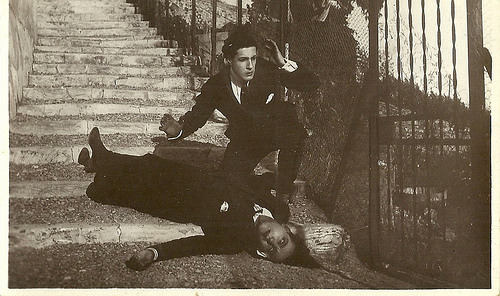
Italian postcard by Unione Cinematografica Italiana. Photo: publicity still for Idillio tragico (Gaston Ravel, 1922). Caption: Pietro finds the dying Oliviero.

Italian postcard by Unione Cinematografica Italiana. Photo: publicity still for Idillio tragico (Gaston Ravel, 1922). Caption: An aristocratic reception.

Italian postcard by Unione Cinematografica Italiana. Photo: publicity still for Idillio tragico (Gaston Ravel, 1922). Caption: Start of the idyll between Ely and Oliviero.

Italian postcard by Unione Cinematografica Italiana. Photo: publicity still for Idillio tragico (Gaston Ravel, 1922). Caption: Oliviero Duprat and Ely of Carlsberg in the first moments of their happiness.

Italian postcard by Unione Cinematografica Italiana. Photo: publicity still for Idillio tragico (Gaston Ravel, 1922). Caption: Jealousy.

Italian postcard by Unione Cinematografica Italiana. Photo: publicity still for Idillio tragico (Gaston Ravel, 1922). Caption: Ely's sadness after Oliviero has abandoned her.

Italian postcard by Unione Cinematografica Italiana. Photo: publicity still for Idillio tragico (Gaston Ravel, 1922). Caption: In order to take revenge on Oliviero, Ely tries to have Pierre d'Hautefeuille fall in love with her.
The idyll that ends in blood
In Idillio tragico the old archduke Henri François (Cav. Giuseppe Piemontesi) tries to prevent the marriage between his assistent Marcel Verdier (Tony Lekain) and the American lady Miss Marsh (Dolly Morgan), afraid to lose his assistent.
His wife, baroness Eleonora/Ely/Elly von Carlsberg ( Helena Makowska ), however, helps the two young ones to crown their love. Tired of her husband's jealousy and insults, she starts an affair with Oliviero/Olivier Duprat (Guido Trento), attaché at the French Embassy, but in reality a cynic upstart who is soon maltreating Eleonora.
Instead his friend Pierre d' Hautefeuille (Ferruccio Lado) truly falls in love with Elly. Olivier wants his friend to break with her but Pierre wants to see her one last time.
The archduke, already sore because of the flight of his assistant, hears about his wife's infidelity and plans an ambush. When he notices a hitman is about to kill Pietro, Olivier shields his friend and dies. Elly and Pierre won't meet again. The idyll tragically ends in blood.

Italian postcard by Unione Cinematografica Italiana. Photo: publicity still for Idillio tragico (Gaston Ravel, 1922). Caption: Aboard the "Sita".

Italian postcard by Unione Cinematografica Italiana. Photo: publicity still for Idillio tragico (Gaston Ravel, 1922). Caption: Jealousy and suspicions by Olivier.

Italian postcard by Unione Cinematografica Italiana. Photo: publicity still for Idillio tragico (Gaston Ravel, 1922). Caption: Ely rejects Oliviero, as she has now fallen in love with Pietro di Hautefeuille.

Italian postcard by Unione Cinematografica Italiana. Photo: publicity still for Idillio tragico (Gaston Ravel, 1922). Caption: The archduke Francesco has in his hands the proof of his wife's infidelity.

Italian postcard by Unione Cinematografica Italiana. Photo: publicity still for Idillio tragico (Gaston Ravel, 1922). Caption: Oliviero's death.

Italian postcard by Unione Cinematografica Italiana. Photo: publicity still for Idillio tragico (Gaston Ravel, 1922). Caption: Pietro finds the dying Oliviero.
Published on May 17, 2016 22:00
May 16, 2016
Olga Desmond
Olga Desmond (1890-1964) was a German dancer and actress. Desmond was the 'heroine of living pictures' and became one of the first to promote nudity on the stage. From 1916 through 1919 she appeared in various films.

German postcard by Hermann Leiser, Berlin-Wilm., no 1725. Photo: Ernst Schneider. Collection: Didier Hanson.
Call it Daring or Bold
Olga Desmond was born Olga Antonie Sellin in Allenstein in East Prussia (now Olsztyn, Poland) 1n 1890. Desmond studied drama and earned her living as a model for artists and painters in Berlin.
In 1907 she joined a group of artists and appeared as Venus during the group's nine-month tour at the London Pavilion where they put on 'plastic representations.' Her dance performances were derived from classical poses and pantomime. She was always dancing barefoot, pretty scandalous for that time, and became most famous for her nude dance performances with special stage make-up.
Back in Berlin she co-founded the Association for Ideal Culture and gave shows called 'living pictures" in which she posed after the manner of ancient classical works of art. These so-called 'Evenings of Beauty' (Schönheitsabende) were prohibited on more than one occasion starting from 1908, because the actors usually posed nude or wearing only bodypaint. She became the 'heroine of living pictures' and she gave guest performances in Great Britain, Austria, USA and Russia.
In St. Petersburg, Russia, Desmond became one of the first to promote nudity on the stage in the summer of 1908. Desmond’s 'Evenings of Beauty' quickly became the subject of a great debate in the Russian media. At least one of the representatives of official 'justice' wanted to haul Desmond into court for 'seduction.' Desmond herself persistently defended her right to appear naked. "Call it daring or bold, or however you want to describe my appearance on the stage, but this requires art, and it (art) is my only deity, before whom I bow and for which I am prepared to make all possible sacrifices," she told the Russian press, cited on Wikipedia .
"I decided to break the centuries-old heavy chains, created by people themselves. When I go out on stage completely naked, I am not ashamed, I am not embarrassed, because I come out before the public just as I am, loving all that is beautiful and graceful. There was never a case when my appearance before the public evoked any cynical observations or dirty ideas." The authorities in St. Petersburg paid little attention to the explanations offered by the dancer from Berlin, and her first appearance in the imperial Russian capital was also her last: further shows were forbidden by the mayor.
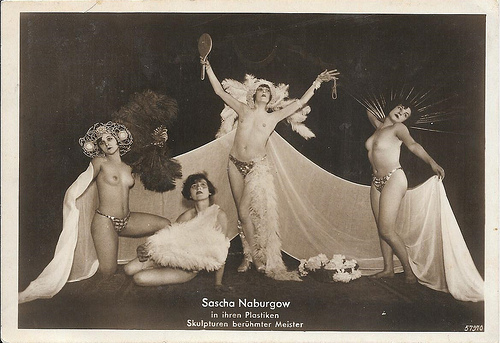
German postcard by Gebr. Garloff, Magdeburg, no. 57270, ca. 1925. Collection: Didier Hanson. Caption: Sascha Naburgow in her performance Plastic Sculptures by famous masters.
Scandalous also meant Well-known
Olga Desmond was no less the subject of controversy in her own country. In 1909 her appearance in the Berlin Wintergarten was the cause of such a scandal that it became a subject of discussion even in the Prussian State Assembly. But 'scandalous' also meant 'well-known', and as a result of her renown, there were cosmetic products that carried her name.
One of her performances was filmed in 1909, Hallo! Die grosse Revue: Der Schönheitsabend (1909). She travelled through Germany on numerous tours until 1914, when she married a Hungarian large-landowner, and went off with him to his estate.
From 1915 through 1919 she appeared in various films including Nocturno (Heinrich Bolten-Baeckers, 1915), Seifenblasen/Soap Bubbles (Heinrich Bolten-Baeckers, 1916) with Carl Auen , Postkarten-Modell/Postcard model (Heinrich Bolten-Baeckers, 1917) with Leo Peukert, and Der Mut zur Sünde/Courage for sin (Heinrich Bolten-Baeckers, Robert Leffler, 1918) opposite the later well-known Hans Albers .
In 1917 she separated from her husband and returned to the stage. Her first appearance in 1917 took place at the Theater der Königlichen Hochschule (Theatre of the Royal University) in Berlin. In the same year she appeared in a performance of Carmen in Cologne. She presented dance evenings and other things in Warsaw, Breslau (now Wrocław), and Kattowitz (now Katowice).
Thereafter, she made fewer public appearances and from 1922 devoted herself entirely to teaching. Among her best-known students was Hertha Feist, who later became a member of the dance group of Rudolf von Laban. After the First World War she married her second husband, Georg Piek, a Jewish businessman with a studio for stage equipment, decorations, and special fabrics. After 1933 Piek left Germany.
Olga Desmond continued to manage the business. After World War II, Desmond lived in the eastern part of Berlin. When the wall was built, she was unable to leave. In her late years, forgotten by the public, she worked as a cleaning woman. To make a living, she also sold vintage postcards and other memorabilia from her time as a renowned dancer. Olga Desmond died in 1964 in East-Berlin, GDR. She was 73.
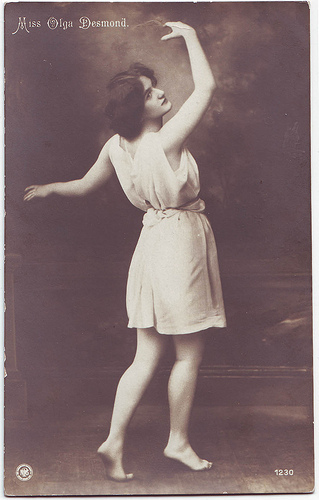
German postcard by NPG, no. 1230. Collection: Manuel Palomino Arjona (Flickr).
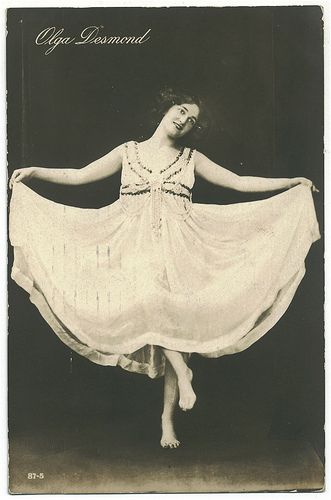
German postcard by PG, no. 87-5. Collection: Manuel Palomino Arjona (Flickr).
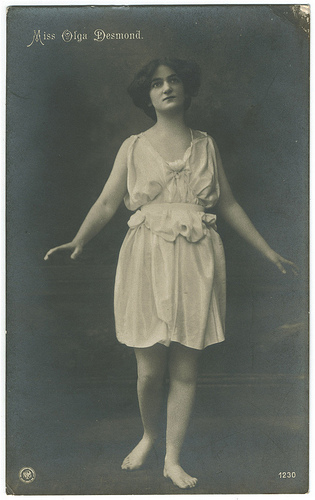
German postcard by NPG, no. 1230. Collection: Manuel Palomino Arjona (Flickr).
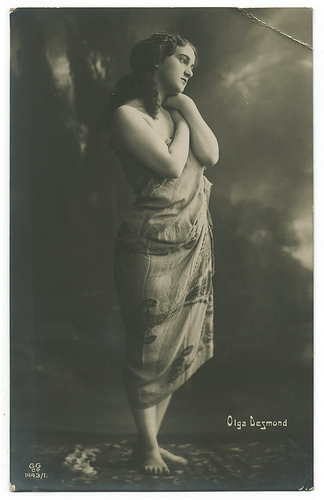
German postcard by GG, no. 1443-1. Collection: Manuel Palomino Arjona (Flickr).
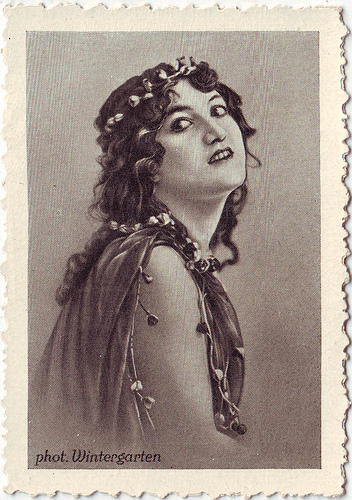
German collectors card by Gold Saba in the Series Berühmte Tänzerinnen, no. 90. Collection: Manuel Palomino Arjona (Flickr).
Sources: Thomas Staedeli (Cyranos), Boudoir Cards, Wikipedia and .

German postcard by Hermann Leiser, Berlin-Wilm., no 1725. Photo: Ernst Schneider. Collection: Didier Hanson.
Call it Daring or Bold
Olga Desmond was born Olga Antonie Sellin in Allenstein in East Prussia (now Olsztyn, Poland) 1n 1890. Desmond studied drama and earned her living as a model for artists and painters in Berlin.
In 1907 she joined a group of artists and appeared as Venus during the group's nine-month tour at the London Pavilion where they put on 'plastic representations.' Her dance performances were derived from classical poses and pantomime. She was always dancing barefoot, pretty scandalous for that time, and became most famous for her nude dance performances with special stage make-up.
Back in Berlin she co-founded the Association for Ideal Culture and gave shows called 'living pictures" in which she posed after the manner of ancient classical works of art. These so-called 'Evenings of Beauty' (Schönheitsabende) were prohibited on more than one occasion starting from 1908, because the actors usually posed nude or wearing only bodypaint. She became the 'heroine of living pictures' and she gave guest performances in Great Britain, Austria, USA and Russia.
In St. Petersburg, Russia, Desmond became one of the first to promote nudity on the stage in the summer of 1908. Desmond’s 'Evenings of Beauty' quickly became the subject of a great debate in the Russian media. At least one of the representatives of official 'justice' wanted to haul Desmond into court for 'seduction.' Desmond herself persistently defended her right to appear naked. "Call it daring or bold, or however you want to describe my appearance on the stage, but this requires art, and it (art) is my only deity, before whom I bow and for which I am prepared to make all possible sacrifices," she told the Russian press, cited on Wikipedia .
"I decided to break the centuries-old heavy chains, created by people themselves. When I go out on stage completely naked, I am not ashamed, I am not embarrassed, because I come out before the public just as I am, loving all that is beautiful and graceful. There was never a case when my appearance before the public evoked any cynical observations or dirty ideas." The authorities in St. Petersburg paid little attention to the explanations offered by the dancer from Berlin, and her first appearance in the imperial Russian capital was also her last: further shows were forbidden by the mayor.

German postcard by Gebr. Garloff, Magdeburg, no. 57270, ca. 1925. Collection: Didier Hanson. Caption: Sascha Naburgow in her performance Plastic Sculptures by famous masters.
Scandalous also meant Well-known
Olga Desmond was no less the subject of controversy in her own country. In 1909 her appearance in the Berlin Wintergarten was the cause of such a scandal that it became a subject of discussion even in the Prussian State Assembly. But 'scandalous' also meant 'well-known', and as a result of her renown, there were cosmetic products that carried her name.
One of her performances was filmed in 1909, Hallo! Die grosse Revue: Der Schönheitsabend (1909). She travelled through Germany on numerous tours until 1914, when she married a Hungarian large-landowner, and went off with him to his estate.
From 1915 through 1919 she appeared in various films including Nocturno (Heinrich Bolten-Baeckers, 1915), Seifenblasen/Soap Bubbles (Heinrich Bolten-Baeckers, 1916) with Carl Auen , Postkarten-Modell/Postcard model (Heinrich Bolten-Baeckers, 1917) with Leo Peukert, and Der Mut zur Sünde/Courage for sin (Heinrich Bolten-Baeckers, Robert Leffler, 1918) opposite the later well-known Hans Albers .
In 1917 she separated from her husband and returned to the stage. Her first appearance in 1917 took place at the Theater der Königlichen Hochschule (Theatre of the Royal University) in Berlin. In the same year she appeared in a performance of Carmen in Cologne. She presented dance evenings and other things in Warsaw, Breslau (now Wrocław), and Kattowitz (now Katowice).
Thereafter, she made fewer public appearances and from 1922 devoted herself entirely to teaching. Among her best-known students was Hertha Feist, who later became a member of the dance group of Rudolf von Laban. After the First World War she married her second husband, Georg Piek, a Jewish businessman with a studio for stage equipment, decorations, and special fabrics. After 1933 Piek left Germany.
Olga Desmond continued to manage the business. After World War II, Desmond lived in the eastern part of Berlin. When the wall was built, she was unable to leave. In her late years, forgotten by the public, she worked as a cleaning woman. To make a living, she also sold vintage postcards and other memorabilia from her time as a renowned dancer. Olga Desmond died in 1964 in East-Berlin, GDR. She was 73.

German postcard by NPG, no. 1230. Collection: Manuel Palomino Arjona (Flickr).

German postcard by PG, no. 87-5. Collection: Manuel Palomino Arjona (Flickr).

German postcard by NPG, no. 1230. Collection: Manuel Palomino Arjona (Flickr).

German postcard by GG, no. 1443-1. Collection: Manuel Palomino Arjona (Flickr).

German collectors card by Gold Saba in the Series Berühmte Tänzerinnen, no. 90. Collection: Manuel Palomino Arjona (Flickr).
Sources: Thomas Staedeli (Cyranos), Boudoir Cards, Wikipedia and .
Published on May 16, 2016 22:00
May 15, 2016
Madeleine Lebeau (1923-2016)
On 1 May 2016, French actress Madeleine Lebeau (1923-2016) passed away in Estepona, Costa del Sol, Spain. She was the last surviving cast member of the film classic Casablanca (1942). Lebeau also appeared in French, British, Spanish and Italian films. She was 92.

French postcard by Editions du Globe, no. 194. Photo: Sam Lévin.
Warner Bros
Marie Madeleine Berthe LeBeau was born in Antony, Hauts-de-Seine, France, in 1923 (some sources say 1921).
In her teens, she landed a tiny role in a play with Marcel Dalio , who was about 20 years her senior and struck by her beauty. They soon married. As Madeleine Lebeau she made her screen debut in the drama, Jeunes filles en détresse/Young Girls in Trouble (Georg Wilhelm Pabst, 1939).
In 1940, she fled Nazi-occupied France with Dalio. They left Paris just hours ahead of the invading German army; Dalio’s image had been used in Nazi posters to identify Jewish-looking features. They made their way to Lisbon and, using what turned out to be forged Chilean visas, booked passage on a Portuguese cargo ship, the Quanza, that was taking more than 300 refugees to the west.
The couple ended up in Hollywood. There, Lebeau appeared for Warner Bros. in such films as the romantic drama Hold Back the Dawn (Mitchell Leisen, 1941), starring Charles Boyer and Olivia de Havilland, and Gentleman Jim (Raoul Walsh, 1942) with Errol Flynn as the boxing champ James J. Corbett.
With Marcel Dalio she appeared then in the classic Casablanca (Michael Curtiz, 1942). Lebeau played Yvonne, Humphrey Bogart's Rick Blaine's spurned lover. In a famous scene, she tearfully shouts "Vive La France", after the clientele in Rick's Café sing La Marseillaise to drown out singing by German soldiers. Lebeau hoped Casablanca would catapult her to great demand in Hollywood. It did not.
In 1942 the marriage with Dalio ended in a divorce. As a freelancer, she earned supporting roles in the French underground drama Paris After Dark (Léonide Moguy, 1943) with George Sanders and Philip Dorn , and the musical Music for Millions (Henry Koster, 1944), which was nominated for an Academy Award in 1946.
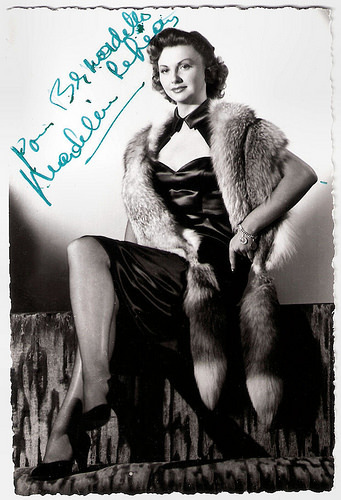
French autograph card.

East-German postcard by VEB Progress Film-Vertrieb, Berlin, no. 1431. Photo: publicity still for La Picara Molinera/The Miller's Saucy Wife (Léon Klimovsky, 1955).
Fellini
After the war, Madeleine Lebeau returned to Europe and appeared in 20 more films. These included Les Chouans/The Royalists (Henri Calef, 1947), the English drama Cage of Gold (Basil Dearden, 1950) starring Jean Simmons , and the comedy La Parisienne (Michel Boisrond, 1957), featuring Brigitte Bardot .
Lebeau had a rare leading role in Dupont Barbès/Sins of Madeleine (Henri Lepage, 1951), about a prostitute who uses the ruse of pregnancy to end relationships with men, only to find one of her clients is delighted at the prospect of being a father.
Her subsequent work includes the role of a temperamental French actress in Federico Fellini's 8 1/2 (1963). During the 1960s, she also appeared in the Spaghetti Western Desafío en Río Bravo/Gunmen of the Rio Grande (Tulio Demicheli, 1964) with Guy Madison and Angélique, marquise des anges/Angélique (Bernard Borderie, 1964), the first of the Angélique cycle.
Her film career ended by the late 1960s, and she remained in Rome. In 1988 she married Italian screenwriter Tullio Pinelli who had co-written 8 1/2. He passed away in 2009 at 100.
Her stepson, documentary filmmaker and mountaineer Carlo Alberto Pinelli broke the news that Lebeau had died after suffering a broken thigh bone.
Scene from Casablanca (1942). Source: myyouyou111 (YouTube).
Another scene from Casablanca (1942). Source: Manek Shergill (YouTube).
Sources: Adam Bernstein (Washington Post), Tom B. (Westerns...All'Italiana!), BBC, Wikipedia and .

French postcard by Editions du Globe, no. 194. Photo: Sam Lévin.
Warner Bros
Marie Madeleine Berthe LeBeau was born in Antony, Hauts-de-Seine, France, in 1923 (some sources say 1921).
In her teens, she landed a tiny role in a play with Marcel Dalio , who was about 20 years her senior and struck by her beauty. They soon married. As Madeleine Lebeau she made her screen debut in the drama, Jeunes filles en détresse/Young Girls in Trouble (Georg Wilhelm Pabst, 1939).
In 1940, she fled Nazi-occupied France with Dalio. They left Paris just hours ahead of the invading German army; Dalio’s image had been used in Nazi posters to identify Jewish-looking features. They made their way to Lisbon and, using what turned out to be forged Chilean visas, booked passage on a Portuguese cargo ship, the Quanza, that was taking more than 300 refugees to the west.
The couple ended up in Hollywood. There, Lebeau appeared for Warner Bros. in such films as the romantic drama Hold Back the Dawn (Mitchell Leisen, 1941), starring Charles Boyer and Olivia de Havilland, and Gentleman Jim (Raoul Walsh, 1942) with Errol Flynn as the boxing champ James J. Corbett.
With Marcel Dalio she appeared then in the classic Casablanca (Michael Curtiz, 1942). Lebeau played Yvonne, Humphrey Bogart's Rick Blaine's spurned lover. In a famous scene, she tearfully shouts "Vive La France", after the clientele in Rick's Café sing La Marseillaise to drown out singing by German soldiers. Lebeau hoped Casablanca would catapult her to great demand in Hollywood. It did not.
In 1942 the marriage with Dalio ended in a divorce. As a freelancer, she earned supporting roles in the French underground drama Paris After Dark (Léonide Moguy, 1943) with George Sanders and Philip Dorn , and the musical Music for Millions (Henry Koster, 1944), which was nominated for an Academy Award in 1946.

French autograph card.

East-German postcard by VEB Progress Film-Vertrieb, Berlin, no. 1431. Photo: publicity still for La Picara Molinera/The Miller's Saucy Wife (Léon Klimovsky, 1955).
Fellini
After the war, Madeleine Lebeau returned to Europe and appeared in 20 more films. These included Les Chouans/The Royalists (Henri Calef, 1947), the English drama Cage of Gold (Basil Dearden, 1950) starring Jean Simmons , and the comedy La Parisienne (Michel Boisrond, 1957), featuring Brigitte Bardot .
Lebeau had a rare leading role in Dupont Barbès/Sins of Madeleine (Henri Lepage, 1951), about a prostitute who uses the ruse of pregnancy to end relationships with men, only to find one of her clients is delighted at the prospect of being a father.
Her subsequent work includes the role of a temperamental French actress in Federico Fellini's 8 1/2 (1963). During the 1960s, she also appeared in the Spaghetti Western Desafío en Río Bravo/Gunmen of the Rio Grande (Tulio Demicheli, 1964) with Guy Madison and Angélique, marquise des anges/Angélique (Bernard Borderie, 1964), the first of the Angélique cycle.
Her film career ended by the late 1960s, and she remained in Rome. In 1988 she married Italian screenwriter Tullio Pinelli who had co-written 8 1/2. He passed away in 2009 at 100.
Her stepson, documentary filmmaker and mountaineer Carlo Alberto Pinelli broke the news that Lebeau had died after suffering a broken thigh bone.
Scene from Casablanca (1942). Source: myyouyou111 (YouTube).
Another scene from Casablanca (1942). Source: Manek Shergill (YouTube).
Sources: Adam Bernstein (Washington Post), Tom B. (Westerns...All'Italiana!), BBC, Wikipedia and .
Published on May 15, 2016 22:00
May 14, 2016
Carlos Thompson
Handsome Carlos Thompson (1923-1990) was an Argentinian heartthrob of German-Swiss parentage. He started his career in Argentina playing leading roles on stage and in films. In the 1950s, he went to Hollywood and was typically cast as a European womaniser opposite such stars as Lana Turner and Yvonne De Carlo. He moved to Europe and appeared in a large number of German films. In the late 1960s, Thompson left acting to become a writer and TV producer.
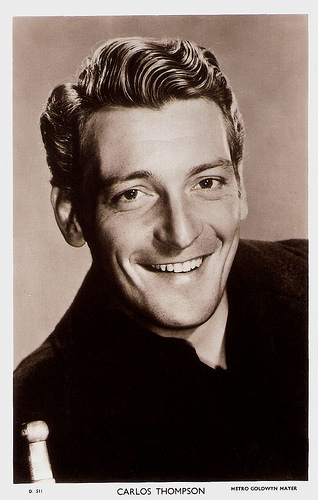
British postcard in the Picturegoer series, no. D 511. Photo: Metro-Goldwyn-Mayer.
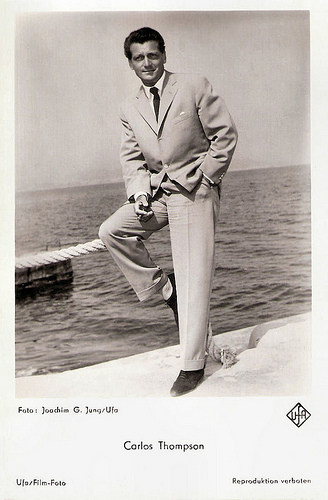
Austrian/German postcard by Verlag Hubmann (HDH), Wien / Universum-Film Aktiengesellschaft (Ufa), Berlin, no. 7205 2. Photo: Joachim J. Jung / Ufa.
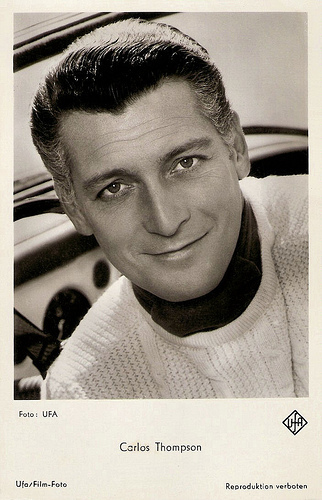
German postcard by Universum-Film Aktiengesellschaft (Ufa), Berlin-Tempelhof, no. FK 4298. Retail price: 25 Pfg. Photo: Ufa.
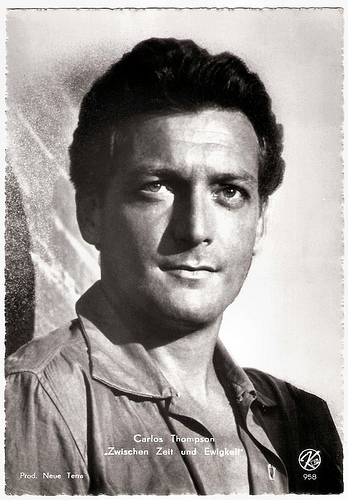
Austrian postcard by Kellner, no. 958. Photo: Neue Terra. Publicity still for Zwischen Zeit und Ewigkeit/Between Time and Eternity (Arthur Maria Rabenalt, 1956).
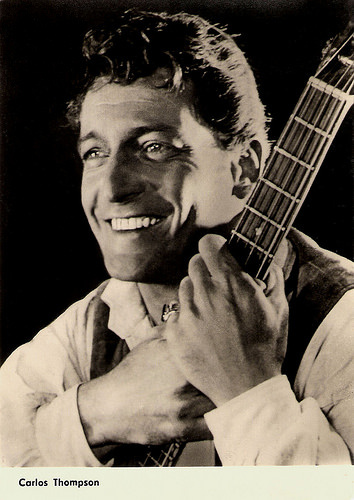
East-German postcard by VEB Progress Filmverlag, Berlin, no. 1107, 1961. Photo: publicity still for Das Wirthaus im Spessart/The Spessart Inn (Kurt Hoffmann, 1958).
The Most Popular Matinee Idol of Argentina
Carlos Thompson was born as Juan Carlos Mundin-Schaffter in Buenos Aires, Argentina in 1923. He was the son of German/Swiss immigrants.
As a 16-year old, he started his film career with a small part in the Argentine production Y mañana serán hombres/Men of Tomorrow (Carlos F. Borcosque, 1939) a drama about teenage delinquents. The following year he played a handsome soldier in the film Fragata Sarmiento (Carlos F. Borcosque, 1940). Four years later he appeared in Viaje sin regreso/Journey of No Return (Pierre Chenal, 1944). On stage in Argentina he played leading roles in plays by Jean Giraudoux, Lope de Vega and Jean Anouilh.
In 1950 he played the title figure in El crimen de Oribe/The Crime of Oribe (Leopoldo Torre Nilsson, Leopoldo Torres Ríos, 1950). At IMDb , Eddie Lawrence writes that it is “one of the best movies of the so-called Golden Era (the 40s) of the Argentine cinema. It was very well directed by one of the best Argentine directors ever, Leopoldo Torres Rios who allowed his son, Leopoldo Torre Nilsson to co-direct the film along him. Based on a short story (not a novel) by Adolfo Bioy Casares, El perjurio de la nieve (The perjury of the snow), the film is a wonderful- and very dramatic and romantic - predecessor of the literary current later known as Magic Realism. Very well photographed in black and white, it had very good actors like Roberto Escalada and Carlos Thompson”.
In 1951 Thompson played a demented murderer in El túnel/The tunnel (León Klimovsky, 1951), based on a controversial novel by Ernesto Sabato. By now Carlos was the most popular matinee idol of Argentina and he starred in several box office hits such as the drama La Pasion Desnuda/Naked Passion (Luis Cesar Amadori, 1952) opposite Mexican star Maria Felix.
He went to Hollywood where he was typically cast as a European womaniser. His Hollywood films include the adventure film Fort Algiers (Lesley Selander, 1953) with Yvonne De Carlo , The Flame and the Flesh (Richard Brooks, 1954) with Lana Turner and Pier Angeli , Valley of the Kings (Robert Pirosh, 1954) with Robert Taylor and Eleanor Parker, and Magic Fire (William Dieterle, 1955) in which he played Franz Liszt, opposite Valentina Cortese .
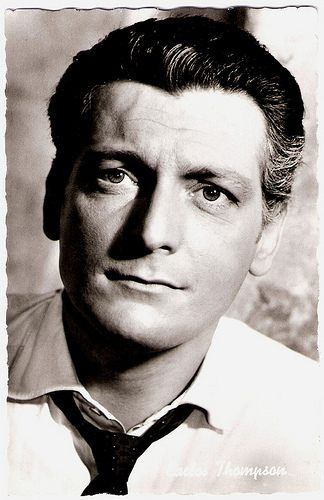
Austrian postcard by Bild und Ton, Postkartenverlag P. Welzmann, Wien, no. 252.
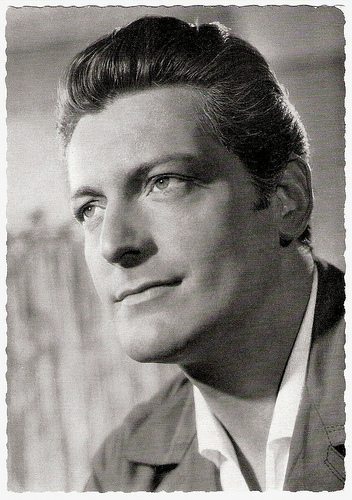
German postcard by Filmbilder-Vertrieb Ernst Freihoff, Essen no. 264. Retail price: 10 Pfg. Photo: Arthur Grimm / CCC-Film.
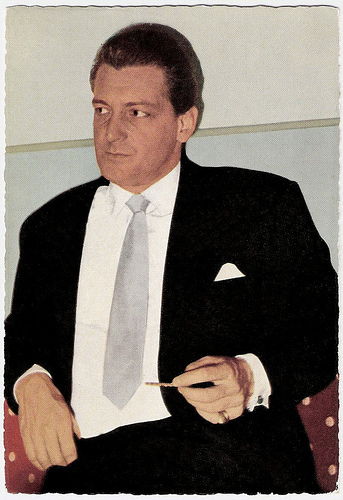
German postcard by WS-Druck, Wanne-Eickel, no. F 135.
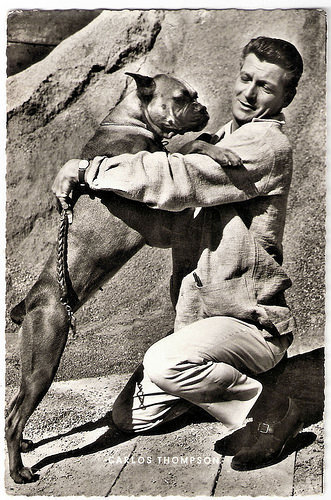
German postcard by Kunst und Bild, Berlin-Charlottenburg, no. A 1822. Photo: J. Clauss / Story-Press.
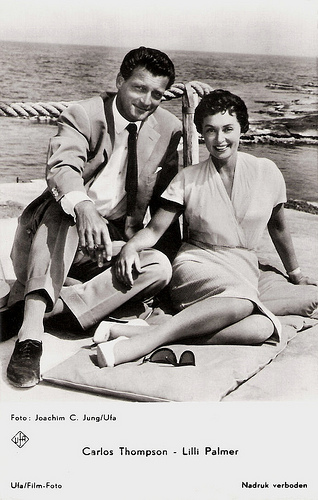
With Lilli Palmer. Dutch postcard by Gebr. Spanjersberg N.V., Rotterdam, no. 4061. Photo: Joachim C. Jung / Ufa.
References to Bisexuality
Carlos Thompson moved to Europe and appeared in the Spanish-British production Tormenta/Thunderstorm (Alfonso Acebal, John Guillermin, 1955-1956) as a fisherman who catches Linda Christian in his nets.
On the set of the German drama Zwischen Zeit und Ewigkeit/Between Time and Eternity (Arthur Maria Rabenalt, 1956), Thompson met actress Lilli Palmer . Following her divorce from Rex Harrison in 1957, Thompson and Palmer married. The couple starred in two other international productions in the early 1960s, but Thompson also appeared in several German productions.
Very successful was the romantic comedy Das Wirtshaus im Spessart/The Spessart Inn (Kurt Hoffmann, 1958) in which he played a highway bandit who kidnaps Liselotte Pulver . Opposite Romy Schneider, he starred in the satire Die Halbzarte/Eva (Rolf Thiele, 1959).
In Mexico, he starred in El último rebelled/The Last Rebel (Miguel Contreras Torres, 1958) opposite Ariadna Welter, the sister of Linda Christian . To English speakers he was chiefly known for his appearance as Carlos Varela in the British TV series The Sentimental Agent (1963). The series told the adventures of an Argentine businessman, owner of an import-export company seated in London. The character was first introduced in an episode of Man of the World, a 1961-62 series starring Craig Stevens as world-rambling photographer Michael Strait.
Thompson’s forty-second and final film was the wartime comedy La vie de château/Chateau Life (Jean-Paul Rappeneau, 1965) with Catherine Deneuve . In the late 1960s, Thompson left acting to become a writer and TV producer. His first success on the European book market was The assassination of Winston Churchill (1969), a refutation of allegations by David Irving (Accident. The Death of General Sikorski, 1967) and the German playwright Rolf Hochhuth (Soldiers, premiered in the UK in 1968, London) that war time premier Winston Churchill had a part in the death of Polish General Władysław Sikorski, who perished in an air plane crash at Gibraltar on July 4, 1943, allegedly due to sabotage.
Although references to him recorded in the diaries of Noel Coward suggest that he was bisexual, Carlos Thompson remained married to Lilli Palmer until her death in 1986. After her death, he returned to Buenos Aires. Four years later, Carlos Thompson committed suicide by a gunshot to his head. He was 67.
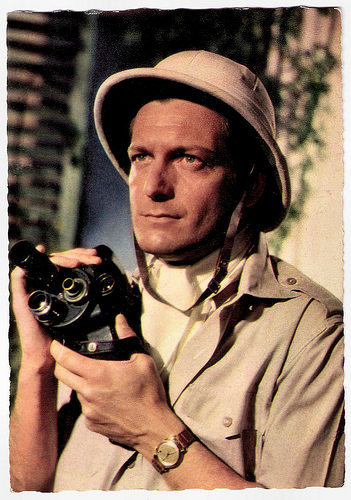
German postcard by Franz Josef Rüdel, Filmpostkartenverlag, Hamburg-Bergedorf, no. FT 20. Photo: CCC / Gloria-Film / Grimm. Publicity still for Franziska (Wolfgang Liebeneiner, 1957).

Belgian postcard by Cox, no. 18. Publicity still for Das Wirtshaus im Spessart/The Spessart Inn (Kurt Hoffmann, 1958).
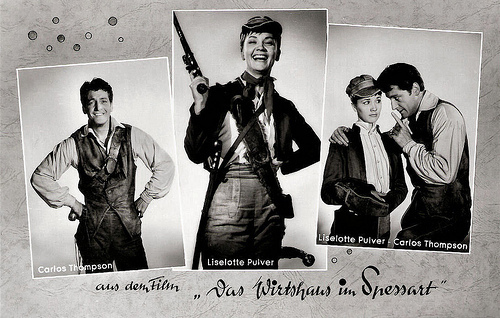
German postcard by Franz Josef Rüdel, Filmpostkartenverlag, Hamburg-Bergedorf, no. 2374. Photo: Witt / Constantin / Ringpress / Vogelmann.Publicity card for Das Wirtshaus im Spessart/The Spessart Inn (1958) with Liselotte Pulver.
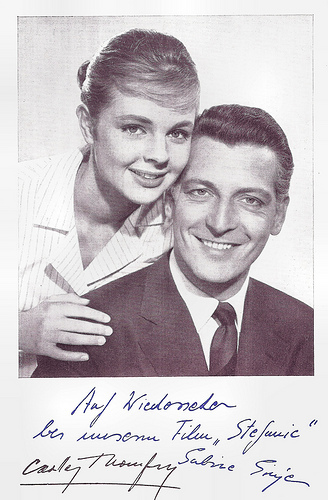
German postcard by Ufa. Photo: Publicity still for Stefanie (Josef von Báky, 1958) with Sabine Sinjen .
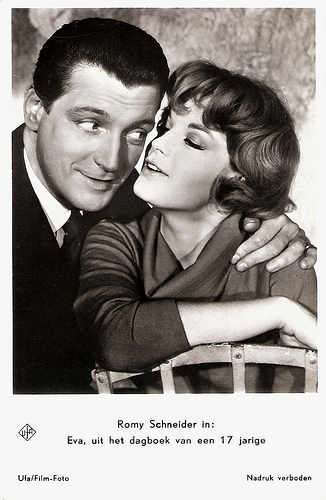
Dutch postcard by Gebr. Spanjersberg N.V., Rotterdam (Dutch licency holder for Universum-Film Aktiengesellschaft (Ufa), Berlin-Tempelhof), no. 1180. Photo: Ufa. Publicity still for Die Halbzarte/Eva (Rolf Thiele, 1959).
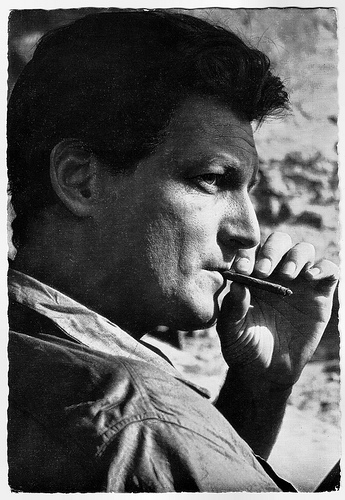
German postcard by WS-Druck, Wanne Eickel, no. 268. Photo: Neue Terra / Europa / Meroth.
Sources: Caroline Hanotte (CineArtistes) (French), Eddie Lawrence (IMDb), Sandra Brennan (AllMovie), Wikipedia, and .

British postcard in the Picturegoer series, no. D 511. Photo: Metro-Goldwyn-Mayer.

Austrian/German postcard by Verlag Hubmann (HDH), Wien / Universum-Film Aktiengesellschaft (Ufa), Berlin, no. 7205 2. Photo: Joachim J. Jung / Ufa.

German postcard by Universum-Film Aktiengesellschaft (Ufa), Berlin-Tempelhof, no. FK 4298. Retail price: 25 Pfg. Photo: Ufa.

Austrian postcard by Kellner, no. 958. Photo: Neue Terra. Publicity still for Zwischen Zeit und Ewigkeit/Between Time and Eternity (Arthur Maria Rabenalt, 1956).

East-German postcard by VEB Progress Filmverlag, Berlin, no. 1107, 1961. Photo: publicity still for Das Wirthaus im Spessart/The Spessart Inn (Kurt Hoffmann, 1958).
The Most Popular Matinee Idol of Argentina
Carlos Thompson was born as Juan Carlos Mundin-Schaffter in Buenos Aires, Argentina in 1923. He was the son of German/Swiss immigrants.
As a 16-year old, he started his film career with a small part in the Argentine production Y mañana serán hombres/Men of Tomorrow (Carlos F. Borcosque, 1939) a drama about teenage delinquents. The following year he played a handsome soldier in the film Fragata Sarmiento (Carlos F. Borcosque, 1940). Four years later he appeared in Viaje sin regreso/Journey of No Return (Pierre Chenal, 1944). On stage in Argentina he played leading roles in plays by Jean Giraudoux, Lope de Vega and Jean Anouilh.
In 1950 he played the title figure in El crimen de Oribe/The Crime of Oribe (Leopoldo Torre Nilsson, Leopoldo Torres Ríos, 1950). At IMDb , Eddie Lawrence writes that it is “one of the best movies of the so-called Golden Era (the 40s) of the Argentine cinema. It was very well directed by one of the best Argentine directors ever, Leopoldo Torres Rios who allowed his son, Leopoldo Torre Nilsson to co-direct the film along him. Based on a short story (not a novel) by Adolfo Bioy Casares, El perjurio de la nieve (The perjury of the snow), the film is a wonderful- and very dramatic and romantic - predecessor of the literary current later known as Magic Realism. Very well photographed in black and white, it had very good actors like Roberto Escalada and Carlos Thompson”.
In 1951 Thompson played a demented murderer in El túnel/The tunnel (León Klimovsky, 1951), based on a controversial novel by Ernesto Sabato. By now Carlos was the most popular matinee idol of Argentina and he starred in several box office hits such as the drama La Pasion Desnuda/Naked Passion (Luis Cesar Amadori, 1952) opposite Mexican star Maria Felix.
He went to Hollywood where he was typically cast as a European womaniser. His Hollywood films include the adventure film Fort Algiers (Lesley Selander, 1953) with Yvonne De Carlo , The Flame and the Flesh (Richard Brooks, 1954) with Lana Turner and Pier Angeli , Valley of the Kings (Robert Pirosh, 1954) with Robert Taylor and Eleanor Parker, and Magic Fire (William Dieterle, 1955) in which he played Franz Liszt, opposite Valentina Cortese .

Austrian postcard by Bild und Ton, Postkartenverlag P. Welzmann, Wien, no. 252.

German postcard by Filmbilder-Vertrieb Ernst Freihoff, Essen no. 264. Retail price: 10 Pfg. Photo: Arthur Grimm / CCC-Film.

German postcard by WS-Druck, Wanne-Eickel, no. F 135.

German postcard by Kunst und Bild, Berlin-Charlottenburg, no. A 1822. Photo: J. Clauss / Story-Press.

With Lilli Palmer. Dutch postcard by Gebr. Spanjersberg N.V., Rotterdam, no. 4061. Photo: Joachim C. Jung / Ufa.
References to Bisexuality
Carlos Thompson moved to Europe and appeared in the Spanish-British production Tormenta/Thunderstorm (Alfonso Acebal, John Guillermin, 1955-1956) as a fisherman who catches Linda Christian in his nets.
On the set of the German drama Zwischen Zeit und Ewigkeit/Between Time and Eternity (Arthur Maria Rabenalt, 1956), Thompson met actress Lilli Palmer . Following her divorce from Rex Harrison in 1957, Thompson and Palmer married. The couple starred in two other international productions in the early 1960s, but Thompson also appeared in several German productions.
Very successful was the romantic comedy Das Wirtshaus im Spessart/The Spessart Inn (Kurt Hoffmann, 1958) in which he played a highway bandit who kidnaps Liselotte Pulver . Opposite Romy Schneider, he starred in the satire Die Halbzarte/Eva (Rolf Thiele, 1959).
In Mexico, he starred in El último rebelled/The Last Rebel (Miguel Contreras Torres, 1958) opposite Ariadna Welter, the sister of Linda Christian . To English speakers he was chiefly known for his appearance as Carlos Varela in the British TV series The Sentimental Agent (1963). The series told the adventures of an Argentine businessman, owner of an import-export company seated in London. The character was first introduced in an episode of Man of the World, a 1961-62 series starring Craig Stevens as world-rambling photographer Michael Strait.
Thompson’s forty-second and final film was the wartime comedy La vie de château/Chateau Life (Jean-Paul Rappeneau, 1965) with Catherine Deneuve . In the late 1960s, Thompson left acting to become a writer and TV producer. His first success on the European book market was The assassination of Winston Churchill (1969), a refutation of allegations by David Irving (Accident. The Death of General Sikorski, 1967) and the German playwright Rolf Hochhuth (Soldiers, premiered in the UK in 1968, London) that war time premier Winston Churchill had a part in the death of Polish General Władysław Sikorski, who perished in an air plane crash at Gibraltar on July 4, 1943, allegedly due to sabotage.
Although references to him recorded in the diaries of Noel Coward suggest that he was bisexual, Carlos Thompson remained married to Lilli Palmer until her death in 1986. After her death, he returned to Buenos Aires. Four years later, Carlos Thompson committed suicide by a gunshot to his head. He was 67.

German postcard by Franz Josef Rüdel, Filmpostkartenverlag, Hamburg-Bergedorf, no. FT 20. Photo: CCC / Gloria-Film / Grimm. Publicity still for Franziska (Wolfgang Liebeneiner, 1957).

Belgian postcard by Cox, no. 18. Publicity still for Das Wirtshaus im Spessart/The Spessart Inn (Kurt Hoffmann, 1958).

German postcard by Franz Josef Rüdel, Filmpostkartenverlag, Hamburg-Bergedorf, no. 2374. Photo: Witt / Constantin / Ringpress / Vogelmann.Publicity card for Das Wirtshaus im Spessart/The Spessart Inn (1958) with Liselotte Pulver.

German postcard by Ufa. Photo: Publicity still for Stefanie (Josef von Báky, 1958) with Sabine Sinjen .

Dutch postcard by Gebr. Spanjersberg N.V., Rotterdam (Dutch licency holder for Universum-Film Aktiengesellschaft (Ufa), Berlin-Tempelhof), no. 1180. Photo: Ufa. Publicity still for Die Halbzarte/Eva (Rolf Thiele, 1959).

German postcard by WS-Druck, Wanne Eickel, no. 268. Photo: Neue Terra / Europa / Meroth.
Sources: Caroline Hanotte (CineArtistes) (French), Eddie Lawrence (IMDb), Sandra Brennan (AllMovie), Wikipedia, and .
Published on May 14, 2016 22:00
May 13, 2016
Ringo Starr
English musician, singer, songwriter and actor Ringo Starr (1940) gained worldwide fame as the drummer for the Beatles. He occasionally sang lead vocals, such as for the hit Yellow Submarine. Starr played key roles in the Beatles' films and appeared in numerous others. After the break-up of The Beatles, Starr released several successful singles, including It Don’t Come Easy and Back Off Boogaloo.
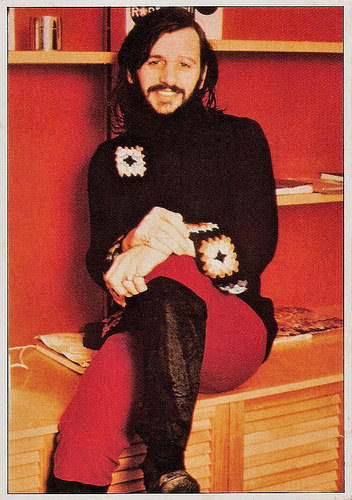
Italian collectors card in the Dzuboks Pop Parada by Panini, Modena, no. 2, 1975.
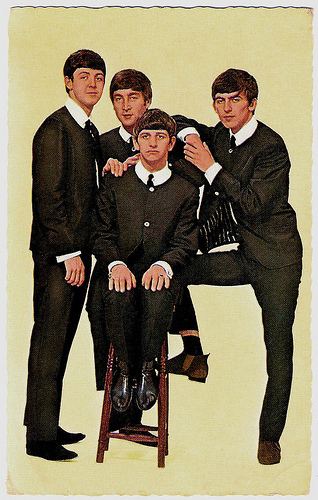
Vintage postcard.
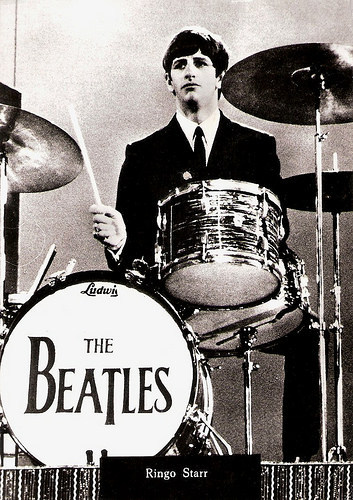
Vintage postcard.
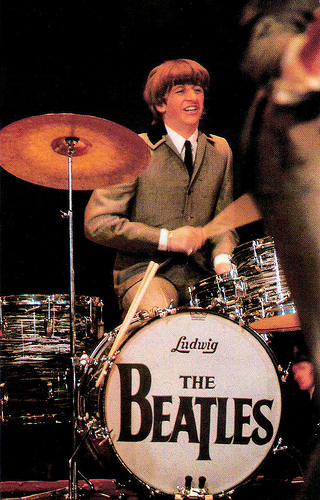
American postcard by Coral-Lee, Rancho Cordova, Ca. in the CL/Personality series, no. 65. Photo: Fred Ward, 1981 / Black Star.
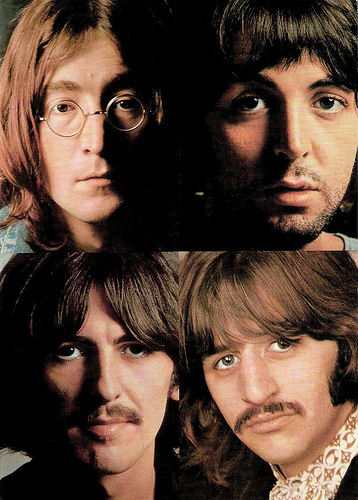
British Postcard by Fotofolio.
Beatlemania
Ringo Starr was born Richard Starkey in a small two-storey house in the working class area of Liverpool, England, in 1940. He was the only child of Elsie (née Gleave) and Richard Starkey, who both worked in a bakery.
During childhood ‘Ritchie’ was twice afflicted by life-threatening illnesses. In 1953, he contracted tuberculosis and was admitted to a sanatorium, where he remained for two years. During his stay the medical staff encouraged their patients to join the hospital band. Ringo played percussion and grew increasingly interested in drumming.
In 1955, he entered the workforce and did some odd jobs. He became a fervent admirer of the UK skiffle craze. In 1957, he cofounded his first band, the Eddie Clayton Skiffle Group. It earned several prestigious local bookings before the skiffle craze faded in early 1958 as American rock and roll became popular in the UK.
When The Beatles formed in 1960, Starr was a member of another Liverpool group, Rory Storm and the Hurricanes. About this time he adopted the stage name Ringo Starr. After achieving moderate success in the UK and Hamburg, he quit the Hurricanes. Starr had performed with The Beatles during a few stand-in engagements while in Hamburg.
In 1962, he joined The Beatles , replacing Pete Best. Ringo contributed to their first hit, Love Me Do, which reached the top of the US singles chart in 1962. Soon, he began receiving an amount of fan mail equal to that of the others, which helped to secure his position within the band. During 1963, The Beatles enjoyed increasing popularity in Britain. By the end of the year, the phenomenon known as Beatlemania had spread throughout the country, and by February 1964 The Beatles had become an international success, performing on The Ed Sullivan Show to a record 73 million viewers.
When The Beatles made their film debut in A Hard Day's Night (Richard Lester, 1964), Starr garnered much praise from critics, who considered both his delivery of deadpan one-liners and his non-speaking scenes highlights of the film. He and the other Beatles were cumulatively nominated for a BAFTA Award for Best Newcomer for their performances in A Hard Day's Night. Hal Erickson at AllMovie : “most of the comedy material went to Ringo, whose Chaplinesque demeanor and droll, deadpan dialogue delivery paid off in big laughs”
After the release of The Beatles ' second feature film, Help! (Richard Lester, 1965), Starr won a Melody Maker poll against his fellow Beatles for his performance as the central character in the film. In 1965, Starr married Maureen Cox, whom he had first met in 1962. By this time the stress and pressure that went along with Beatlemania had reached a peak for him. In August 1966, The Beatles released Revolver, their seventh UK LP. The album included the song Yellow Submarine, which was the only British number one single with Starr as the lead singer.
Later that month and owing to the increasing pressures of touring, the Beatles gave their final concert. For The Beatles ' seminal album, Sgt. Pepper's Lonely Hearts Club Band (1967), Starr sang lead vocals on the Lennon–McCartney composition With a Little Help from My Friends. Brian Epstein's death in August 1967 left The Beatles without management. The band began an ill-fated film project, Magical Mystery Tour (The Beatles, 1967). Starr's growing interest in photography led to his billing as the film's Director of Photography, and his participation in the film's editing was matched only by McCartney.
During the recording of the White Album in 1968, The Beatles ’s collective group dynamic began to decay. Despite a temporary return to congenial relations during the completion of the White Album, production of The Beatles ' fourth feature film, Let It Be (Michael Lindsay-Hogg, 1970), and its accompanying LP, strained the already tenuous cohesion within the band.
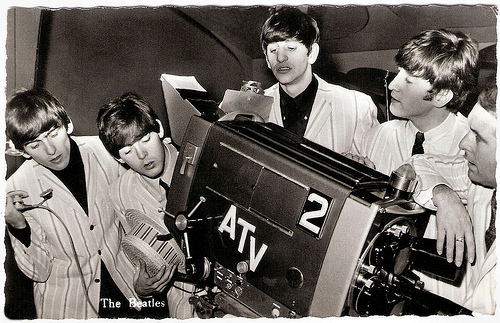
Dutch postcard by Rembrandt N.V., Amsterdam. Sent by mail in 1964.
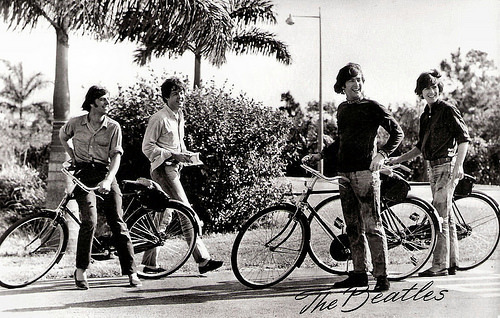
Dutch postcard.
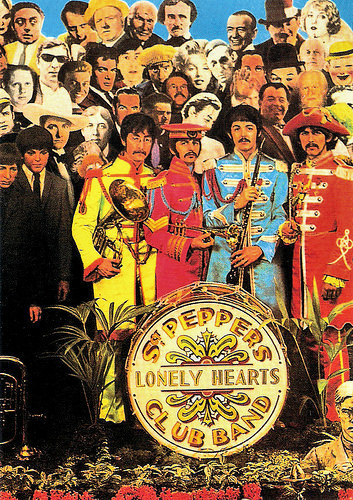
Italian postcard by Gruppo Editoriale Lo Vecchio, Genova. Picture: cover for the album Sgt. Pepper's Lonely Hearts Club Band (1967).
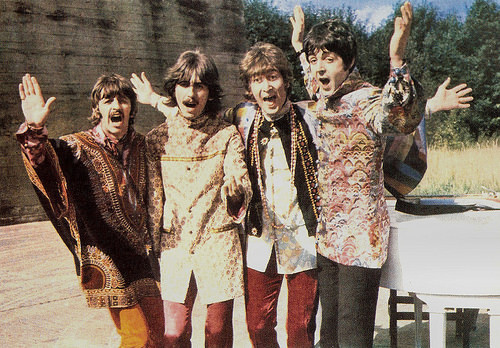
Italian postcard by Gruppo Editoriale Lo Vecchio, Genova. Photo: John Kelly. Publicity still for Magical Mystery Tour (The Beatles, Bernard Knowles, 1967).
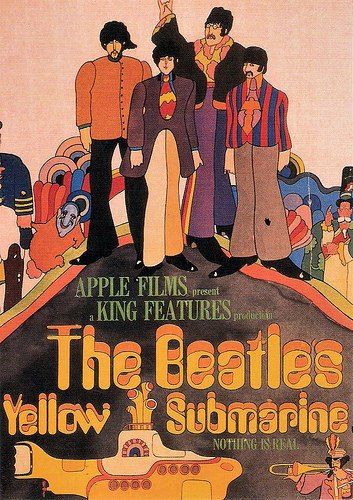
Italian postcard by Gruppo Editoriale Lo Vecchio, Genova. Picture: poster for The Yellow Submarine (George Dunning, 1968). George Martin was the musical director.
Larry the Dwarf
After the break-up of The Beatles in 1970, Ringo Starr played drums on John Lennon 's album John Lennon/Plastic Ono Band (1970), Yoko Ono's Yoko Ono/Plastic Ono Band (1970), and on George Harrison's albums All Things Must Pass (1970), Living in the Material World (1973) and Dark Horse (1974). In 1971, Starr participated in the Concert for Bangladesh, organised by Harrison. They co-wrote the hit single It Don't Come Easy, which reached number four in both the US and the UK.
Starr also acted in several films, including Candy (Christian Marquand, 1968), The Magic Christian (Joseph McGrath, 1969) with Peter Sellers, the Spaghetti Western Blindman (Ferdinando Baldi, 1971), and That'll Be the Day (Claude Whatham, 1973).
In 1971, Ringo also starred as Larry the Dwarf in Frank Zappa's 200 Motels and was featured in fellow rock icon Harry Nilsson's animated film The Point! In 1972, he released his most successful UK single, Back Off Boogaloo, which peaked at number two. Having become friends with the English singer Marc Bolan, Starr made his directorial debut with the T. Rex documentary Born to Boogie (1972).
In 1973, Ringo produced the bizarre horror movie spoof Son of Dracula (Freddie Francis, 1974), in which he co-starred with Harry Nilsson. Starr also released the successful singles Photograph (1973) and You're Sixteen (1974). Both were songs from his critically acclaimed album Ringo (1973), which was a top ten release in both the UK and the US. His next album Goodnight Vienna (1974) was also successful, and featured musical contributions from Lennon, Elton John and Harry Nilsson.
In the following years, his musical career diminished, although he continued to record and remained a familiar celebrity presence. He played the pope in Ken Russell's film Lisztomania (1975), and one of Mae West’s husbands in Sextette (Ken Hughes, 1978). He also appeared as a guest at the Band's farewell concert in 1976, featured in Martin Scorsese’s documentary The Last Waltz (1978).
During the 1980s, Ringo starred in films like Caveman (Carl Gottlieb, 1981) with future wife Barbara Bach and he played a fictionalised version of himself in Paul McCartney 's Give My Regards to Broad Street (Peter Webb, 1984). After having a long period of troubles with alcohol, Ringo and Barbara Bach attended a rehabilitation clinic, and came back to the scene sober.
Starr maintained a high public profile through his narration of the popular children's series Thomas the Tank Engine & Friends (1984-1986), based on the books by the Reverend W. Awdry. In 1989, Starr was nominated for a Daytime Emmy Award for his role as Mr. Conductor in the television series Shining Time Station (1989), a spin-off of Thomas the Tank Engine & Friends. Starr made a cameo appearance on The Simpsons episode Brush with Greatness (1991) and contributed an original song, You Never Know, to the soundtrack of the film Curly Sue (John Hughes, 1991).
Since 1989, he has toured with twelve variations of Ringo Starr & His All-Starr Band. In 1994, Starr began a collaboration with the surviving former Beatles for the Beatles Anthology project. They recorded two new Beatles songs built around solo vocal and piano tapes recorded by Lennon and gave lengthy interviews about the Beatles' career.
Ringo Starr and his first wife Maureen Cox had three children: Zak (1965), Jason (1967) and Lee (1970). Following Starr's repeated infidelities, the couple divorced in 1975. In 1980, while on the set of the film Caveman, Starr met actress Barbara Bach. They were married in 1981. Ringo Starr has seven grandchildren – one from Zak, three from Jason and three from Lee. Starr and Bach split their time between homes in England, Switzerland and Los Angeles.
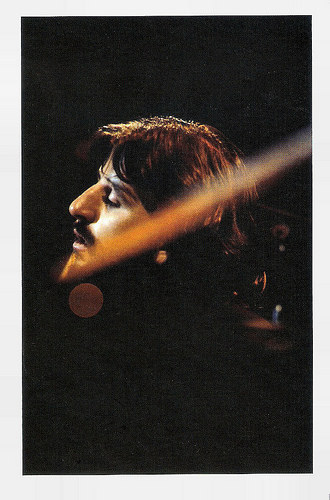
British postcard by The George Harrison Fund for Unicef / Apple. Photo: Barry Feinstein / Tom Wilkes / Alan Pariser / Apple Films. Publicity still for The Concert for Bangladesh (Saul Swimmer, 1972).
Trailer A Hard Day's Night (1964). Source: JoBlo Movie Trailers (YouTube).
Trailer The Magic Christian (1969). Source: Sixstring1965 (YouTube).
Trailer Blindman (1971). Source: The Spaghetti Western Database (YouTube).
Trailer 200 Motels (1971). Source: Sixstring1965 (YouTube).
Trailer Caveman (1981). Source: Peg Mularz (YouTube).
Sources: Hal Erickson (AllMovie), (IMDb), Wikipedia and .

Italian collectors card in the Dzuboks Pop Parada by Panini, Modena, no. 2, 1975.

Vintage postcard.

Vintage postcard.

American postcard by Coral-Lee, Rancho Cordova, Ca. in the CL/Personality series, no. 65. Photo: Fred Ward, 1981 / Black Star.

British Postcard by Fotofolio.
Beatlemania
Ringo Starr was born Richard Starkey in a small two-storey house in the working class area of Liverpool, England, in 1940. He was the only child of Elsie (née Gleave) and Richard Starkey, who both worked in a bakery.
During childhood ‘Ritchie’ was twice afflicted by life-threatening illnesses. In 1953, he contracted tuberculosis and was admitted to a sanatorium, where he remained for two years. During his stay the medical staff encouraged their patients to join the hospital band. Ringo played percussion and grew increasingly interested in drumming.
In 1955, he entered the workforce and did some odd jobs. He became a fervent admirer of the UK skiffle craze. In 1957, he cofounded his first band, the Eddie Clayton Skiffle Group. It earned several prestigious local bookings before the skiffle craze faded in early 1958 as American rock and roll became popular in the UK.
When The Beatles formed in 1960, Starr was a member of another Liverpool group, Rory Storm and the Hurricanes. About this time he adopted the stage name Ringo Starr. After achieving moderate success in the UK and Hamburg, he quit the Hurricanes. Starr had performed with The Beatles during a few stand-in engagements while in Hamburg.
In 1962, he joined The Beatles , replacing Pete Best. Ringo contributed to their first hit, Love Me Do, which reached the top of the US singles chart in 1962. Soon, he began receiving an amount of fan mail equal to that of the others, which helped to secure his position within the band. During 1963, The Beatles enjoyed increasing popularity in Britain. By the end of the year, the phenomenon known as Beatlemania had spread throughout the country, and by February 1964 The Beatles had become an international success, performing on The Ed Sullivan Show to a record 73 million viewers.
When The Beatles made their film debut in A Hard Day's Night (Richard Lester, 1964), Starr garnered much praise from critics, who considered both his delivery of deadpan one-liners and his non-speaking scenes highlights of the film. He and the other Beatles were cumulatively nominated for a BAFTA Award for Best Newcomer for their performances in A Hard Day's Night. Hal Erickson at AllMovie : “most of the comedy material went to Ringo, whose Chaplinesque demeanor and droll, deadpan dialogue delivery paid off in big laughs”
After the release of The Beatles ' second feature film, Help! (Richard Lester, 1965), Starr won a Melody Maker poll against his fellow Beatles for his performance as the central character in the film. In 1965, Starr married Maureen Cox, whom he had first met in 1962. By this time the stress and pressure that went along with Beatlemania had reached a peak for him. In August 1966, The Beatles released Revolver, their seventh UK LP. The album included the song Yellow Submarine, which was the only British number one single with Starr as the lead singer.
Later that month and owing to the increasing pressures of touring, the Beatles gave their final concert. For The Beatles ' seminal album, Sgt. Pepper's Lonely Hearts Club Band (1967), Starr sang lead vocals on the Lennon–McCartney composition With a Little Help from My Friends. Brian Epstein's death in August 1967 left The Beatles without management. The band began an ill-fated film project, Magical Mystery Tour (The Beatles, 1967). Starr's growing interest in photography led to his billing as the film's Director of Photography, and his participation in the film's editing was matched only by McCartney.
During the recording of the White Album in 1968, The Beatles ’s collective group dynamic began to decay. Despite a temporary return to congenial relations during the completion of the White Album, production of The Beatles ' fourth feature film, Let It Be (Michael Lindsay-Hogg, 1970), and its accompanying LP, strained the already tenuous cohesion within the band.

Dutch postcard by Rembrandt N.V., Amsterdam. Sent by mail in 1964.

Dutch postcard.

Italian postcard by Gruppo Editoriale Lo Vecchio, Genova. Picture: cover for the album Sgt. Pepper's Lonely Hearts Club Band (1967).

Italian postcard by Gruppo Editoriale Lo Vecchio, Genova. Photo: John Kelly. Publicity still for Magical Mystery Tour (The Beatles, Bernard Knowles, 1967).

Italian postcard by Gruppo Editoriale Lo Vecchio, Genova. Picture: poster for The Yellow Submarine (George Dunning, 1968). George Martin was the musical director.
Larry the Dwarf
After the break-up of The Beatles in 1970, Ringo Starr played drums on John Lennon 's album John Lennon/Plastic Ono Band (1970), Yoko Ono's Yoko Ono/Plastic Ono Band (1970), and on George Harrison's albums All Things Must Pass (1970), Living in the Material World (1973) and Dark Horse (1974). In 1971, Starr participated in the Concert for Bangladesh, organised by Harrison. They co-wrote the hit single It Don't Come Easy, which reached number four in both the US and the UK.
Starr also acted in several films, including Candy (Christian Marquand, 1968), The Magic Christian (Joseph McGrath, 1969) with Peter Sellers, the Spaghetti Western Blindman (Ferdinando Baldi, 1971), and That'll Be the Day (Claude Whatham, 1973).
In 1971, Ringo also starred as Larry the Dwarf in Frank Zappa's 200 Motels and was featured in fellow rock icon Harry Nilsson's animated film The Point! In 1972, he released his most successful UK single, Back Off Boogaloo, which peaked at number two. Having become friends with the English singer Marc Bolan, Starr made his directorial debut with the T. Rex documentary Born to Boogie (1972).
In 1973, Ringo produced the bizarre horror movie spoof Son of Dracula (Freddie Francis, 1974), in which he co-starred with Harry Nilsson. Starr also released the successful singles Photograph (1973) and You're Sixteen (1974). Both were songs from his critically acclaimed album Ringo (1973), which was a top ten release in both the UK and the US. His next album Goodnight Vienna (1974) was also successful, and featured musical contributions from Lennon, Elton John and Harry Nilsson.
In the following years, his musical career diminished, although he continued to record and remained a familiar celebrity presence. He played the pope in Ken Russell's film Lisztomania (1975), and one of Mae West’s husbands in Sextette (Ken Hughes, 1978). He also appeared as a guest at the Band's farewell concert in 1976, featured in Martin Scorsese’s documentary The Last Waltz (1978).
During the 1980s, Ringo starred in films like Caveman (Carl Gottlieb, 1981) with future wife Barbara Bach and he played a fictionalised version of himself in Paul McCartney 's Give My Regards to Broad Street (Peter Webb, 1984). After having a long period of troubles with alcohol, Ringo and Barbara Bach attended a rehabilitation clinic, and came back to the scene sober.
Starr maintained a high public profile through his narration of the popular children's series Thomas the Tank Engine & Friends (1984-1986), based on the books by the Reverend W. Awdry. In 1989, Starr was nominated for a Daytime Emmy Award for his role as Mr. Conductor in the television series Shining Time Station (1989), a spin-off of Thomas the Tank Engine & Friends. Starr made a cameo appearance on The Simpsons episode Brush with Greatness (1991) and contributed an original song, You Never Know, to the soundtrack of the film Curly Sue (John Hughes, 1991).
Since 1989, he has toured with twelve variations of Ringo Starr & His All-Starr Band. In 1994, Starr began a collaboration with the surviving former Beatles for the Beatles Anthology project. They recorded two new Beatles songs built around solo vocal and piano tapes recorded by Lennon and gave lengthy interviews about the Beatles' career.
Ringo Starr and his first wife Maureen Cox had three children: Zak (1965), Jason (1967) and Lee (1970). Following Starr's repeated infidelities, the couple divorced in 1975. In 1980, while on the set of the film Caveman, Starr met actress Barbara Bach. They were married in 1981. Ringo Starr has seven grandchildren – one from Zak, three from Jason and three from Lee. Starr and Bach split their time between homes in England, Switzerland and Los Angeles.

British postcard by The George Harrison Fund for Unicef / Apple. Photo: Barry Feinstein / Tom Wilkes / Alan Pariser / Apple Films. Publicity still for The Concert for Bangladesh (Saul Swimmer, 1972).
Trailer A Hard Day's Night (1964). Source: JoBlo Movie Trailers (YouTube).
Trailer The Magic Christian (1969). Source: Sixstring1965 (YouTube).
Trailer Blindman (1971). Source: The Spaghetti Western Database (YouTube).
Trailer 200 Motels (1971). Source: Sixstring1965 (YouTube).
Trailer Caveman (1981). Source: Peg Mularz (YouTube).
Sources: Hal Erickson (AllMovie), (IMDb), Wikipedia and .
Published on May 13, 2016 22:00
Paul van Yperen's Blog
- Paul van Yperen's profile
- 13 followers
Paul van Yperen isn't a Goodreads Author
(yet),
but they
do have a blog,
so here are some recent posts imported from
their feed.



